
Art, travel and culture blog
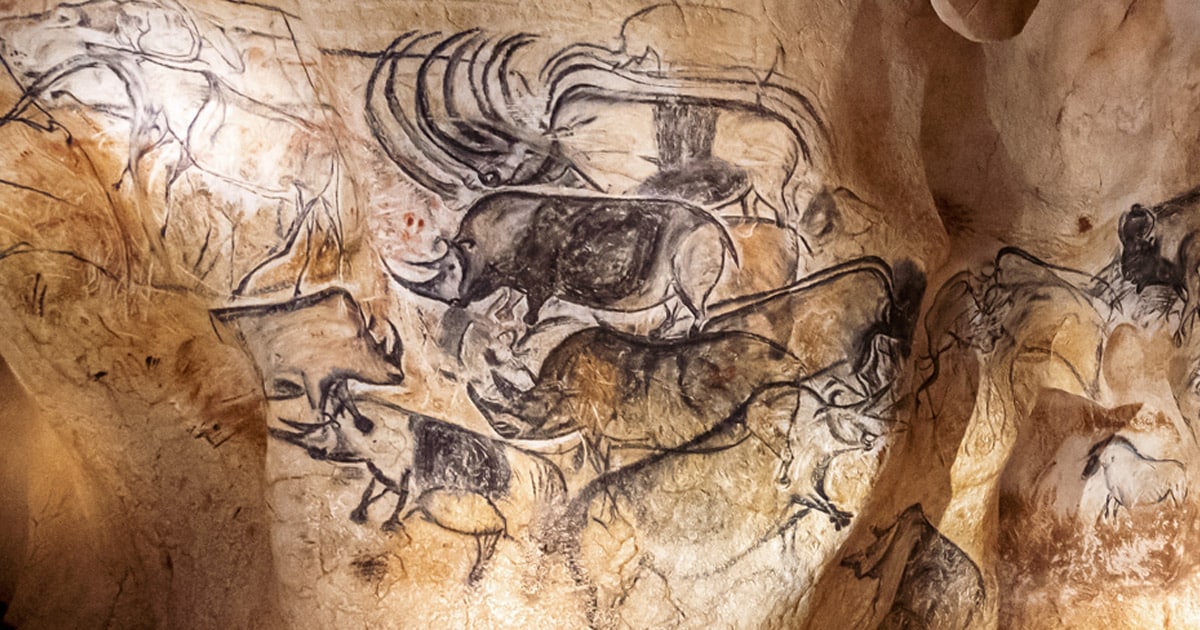

The Chauvet cave, a treasure from the depths of the centuries

It is a treasure from the depths of the centuries, a marvel like you can count on the fingers of one hand. The Chauvet cave and its many ornate drawings are one of those heritage gems that must be preserved .
As soon as it was discovered in 1994, measures were taken to ensure its conservation, but to show the beauty of the cave to the general public, a replica was created, a faithful copy that allows everyone to marvel at this masterpiece of prehistoric art that has nothing to envy to Picasso!
How was the Chauvet cave discovered? When was it discovered? Can we visit it? What can you see? This article provides an update.
The story of the discovery of the Chauvet cave
On the afternoon of 18 December 1994, Jean-Marie Chauvet, Éliette Brunel and Christian Hillaire , three speleology enthusiasts, examined a cliff in the Ardèche, a few hundred metres from the famous Pont d’Arc. Their exploration led to a “blowhole”, i.e. a trickle of air escaping from a wall, indicating that there was a cavity behind it.
After clearing an entrance, they discovered a well some ten metres deep and returned in the evening equipped with a ladder to descend into the cave, an immense cavity that extends over an area equal to almost three football pitches. Eliette Brunel quickly noticed two lines drawn in red ochre on a wall and immediately understood that prehistoric men had been here. A surprise that has only just begun as they prepare to discover the many drawings that have survived the centuries!
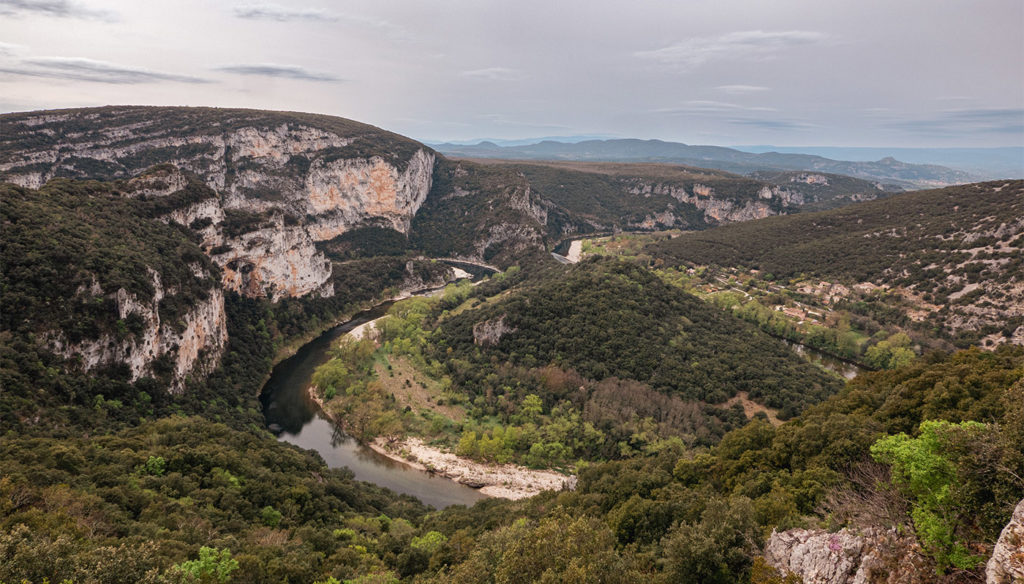
Why does the Chauvet cave bear this name?
Jean-Marie Chauvet, Éliette Brunel and Christian Hillaire are considered to be the “inventors” of the cave since they are the ones who discovered it. But since only one name had to be chosen, the three friends chose Chauvet, Jean-Marie Chauvet being the one who insisted on going to explore this area of the Ardèche on the morning of 18 December 1994.
Ten days later, the DRAC (Regional Directorate of Cultural Affairs) was informed of the discovery and commissioned an expert report from Jean Clottes, Jean-Pierre Daugas and Bernard Gély, all three specialists in Palaeolithic archaeology and art. On 2 January 1995, Jean Clottes’ report recommended several measures to limit access to the cave and avoid repeating the mistakes made at Lascaux, where massive tourist exploitation had irreparably damaged the cave.
How old is the Chauvet cave?
Studies carried out in the cave have revealed that it was occupied during two periods: during the Aurignacian period (from 37 to 33,500 BC) and then during the Gravettian period (from 31 to 28,000 BC). 22,000 years ago, a landslide sealed the natural entrance to the cave, allowing it to be protected and the paintings to be preserved in such good condition.
Chauvet 2: the replica of the Chauvet cave
Very early on, development work was carried out to secure access to the cave and to monitor the health and climate of Chauvet. To preserve it, Jean Clottes’ recommendations were followed: the cave would never be open to the public and only a hundred or so visitors a year (scientists, officials, hand-picked press, etc.) were authorised to enter it, following a very strict protocol.
However, in order to make the cave visible to as many people as possible, the Rhône-Alpes region and the Ardèche General Council launched the project in 2006 to build a reconstruction of the Chauvet cave . Construction began in 2012, a few kilometres from the original cave, and the replica opened to the public in 2015.
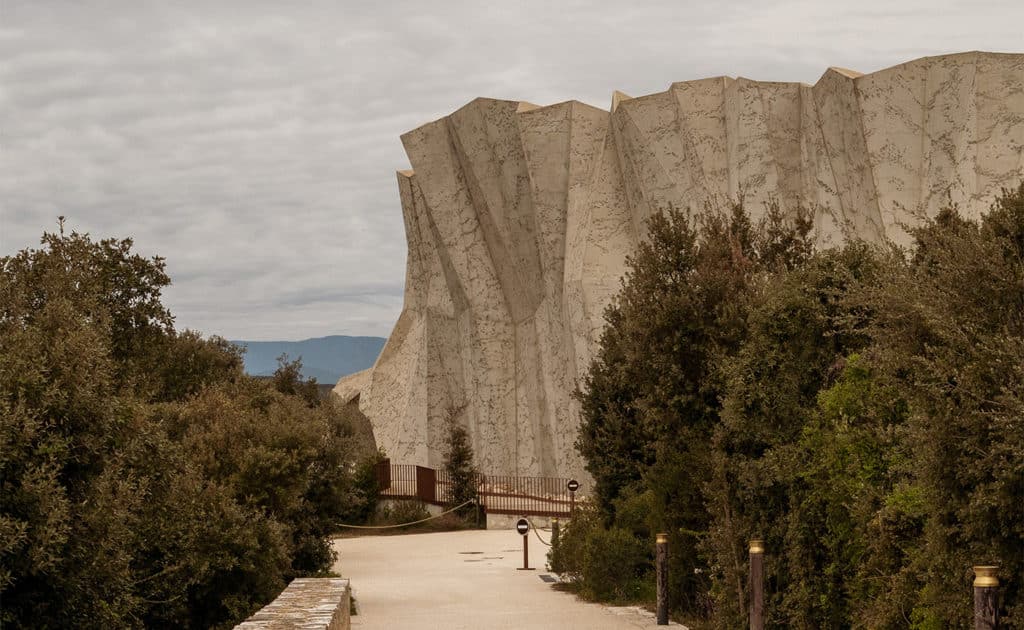
How is a replica of a cave created?
The facsimiles are created from thousands of digital photos that were used to model the cave walls. A team of “forgers”, artists specialised in copying cave art, then came to reproduce each of the drawings centimetre by centimetre on resin panels, using the same pigments and charcoal as the prehistoric men. The restitution is very close to the original cave.
In addition to the drawings, the concretions (geological forms) were also reproduced, as well as the animal bones found in the cave.

What can be seen in the Chauvet cave?
A thousand paintings and engravings have been recorded in the cave . These represent either humans, animals or signs. 447 representations of animals of 14 different species are visible, including the only representation of an owl known to date in cave art.
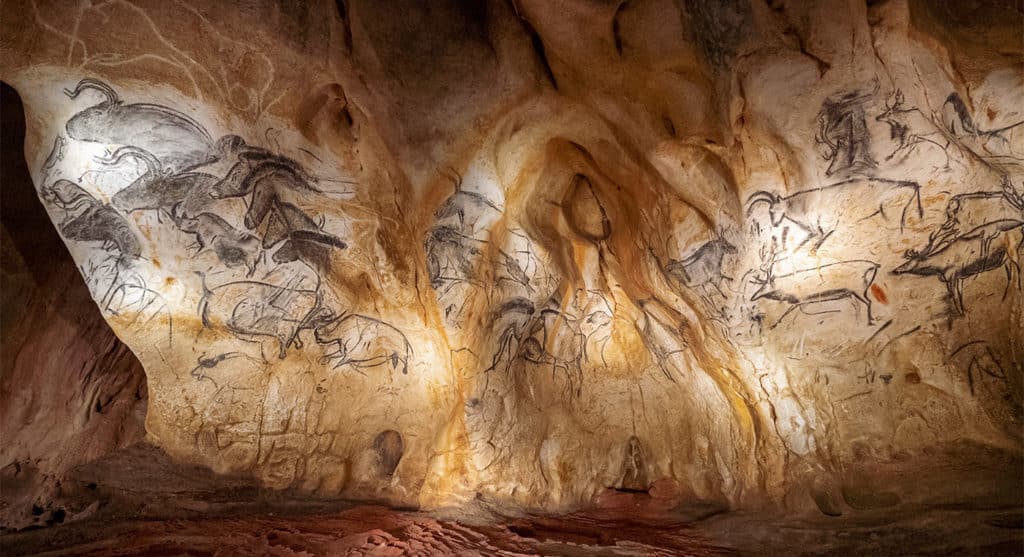
Several methods of drawing were used: the “palm-dot” technique by applying a coloured palm to the wall; scraping engravings; or charcoal point drawings.
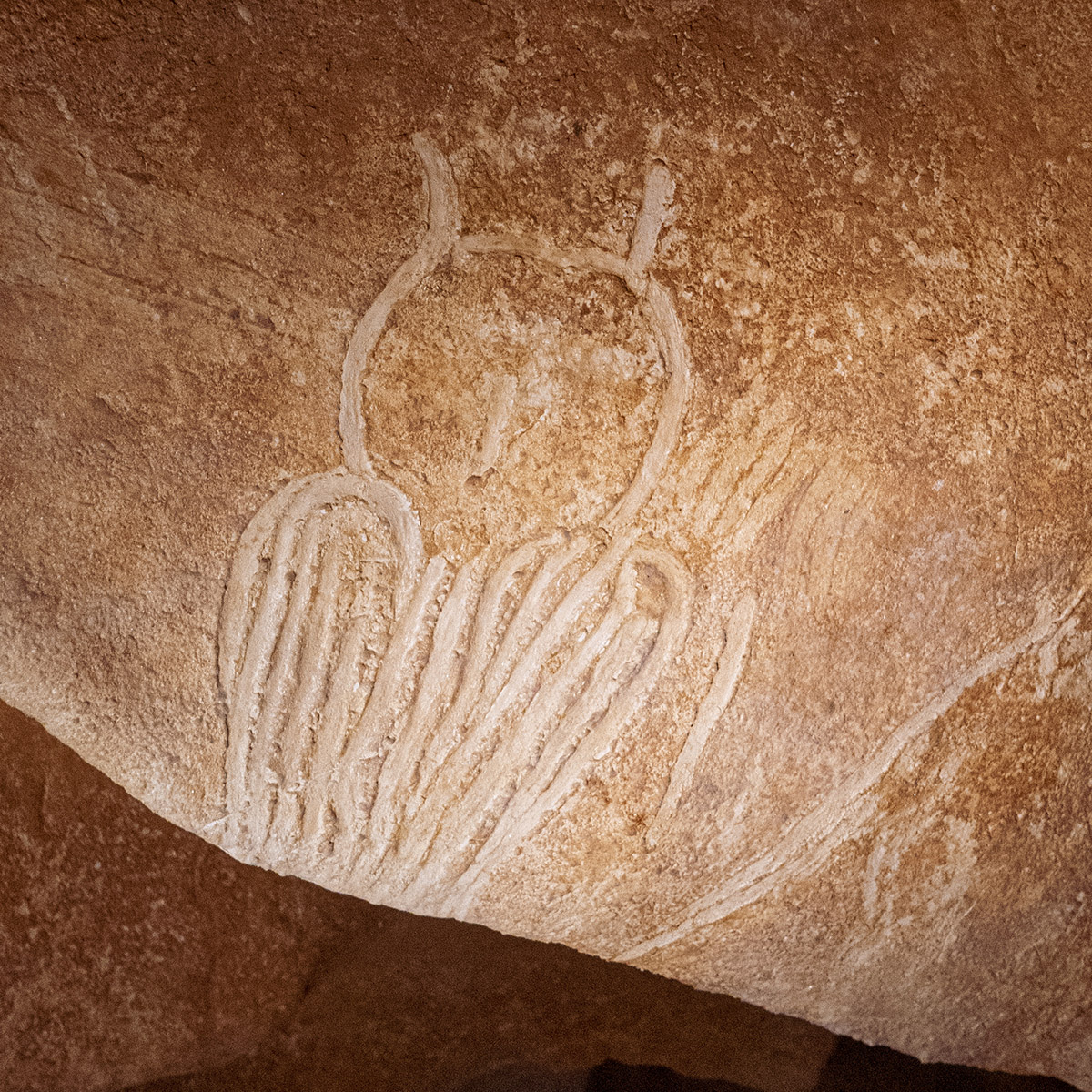
Two large frescoes are breathtaking and show that the artists who created these drawings mastered several techniques such as the use of shades, the outlining of contours or the exploitation of the relief of the walls for the benefit of the drawings. The art of Chauvet thus made it possible to become aware of the artistic talent of these men and women .
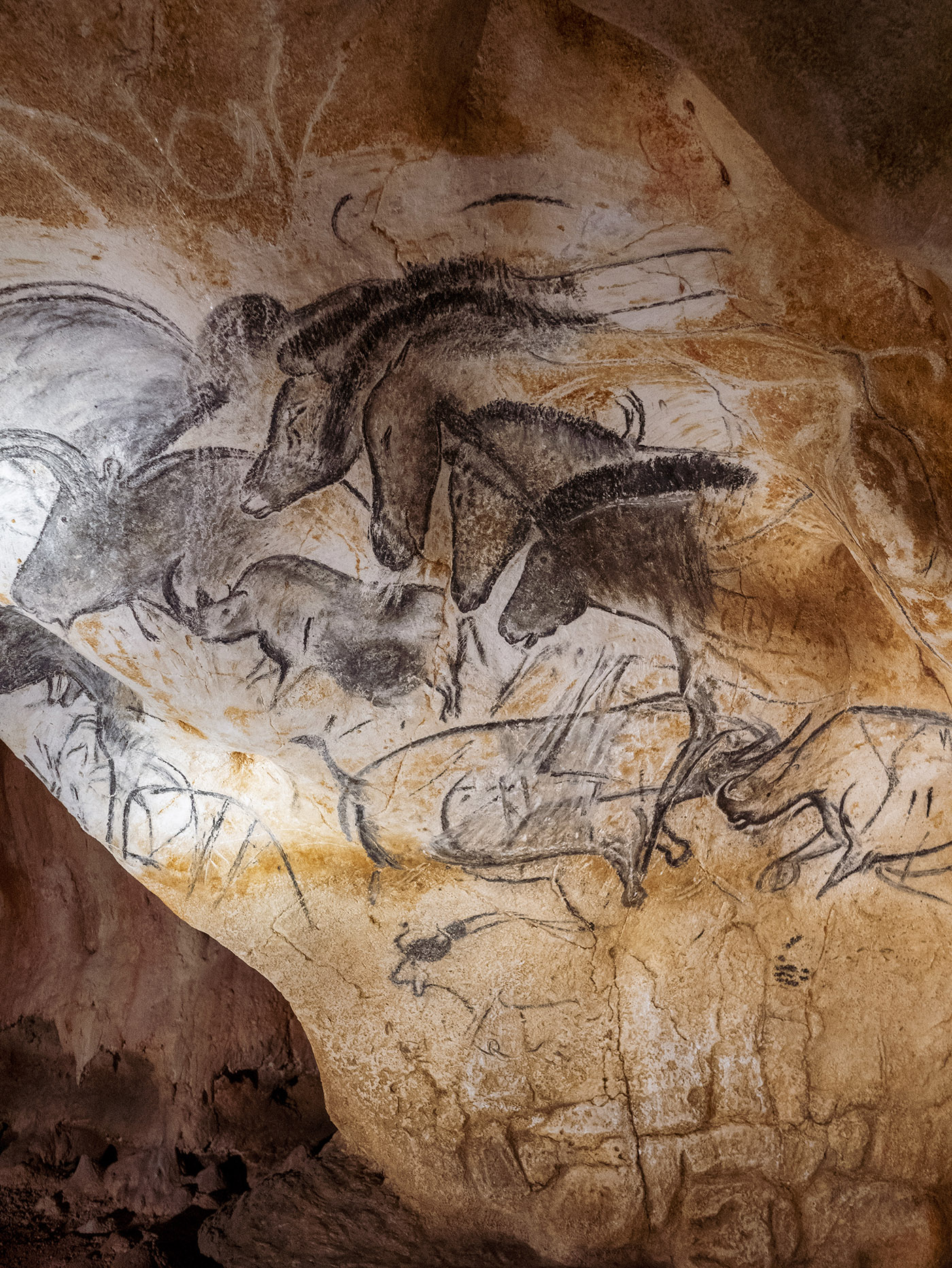
It is also worth noting that although today the replica can be visited in full light, the original cave was discovered in its time by the light of a torch which, with the effects of shadows projected on the walls, brought the paintings to life, thus creating what was perhaps the first film in the world!
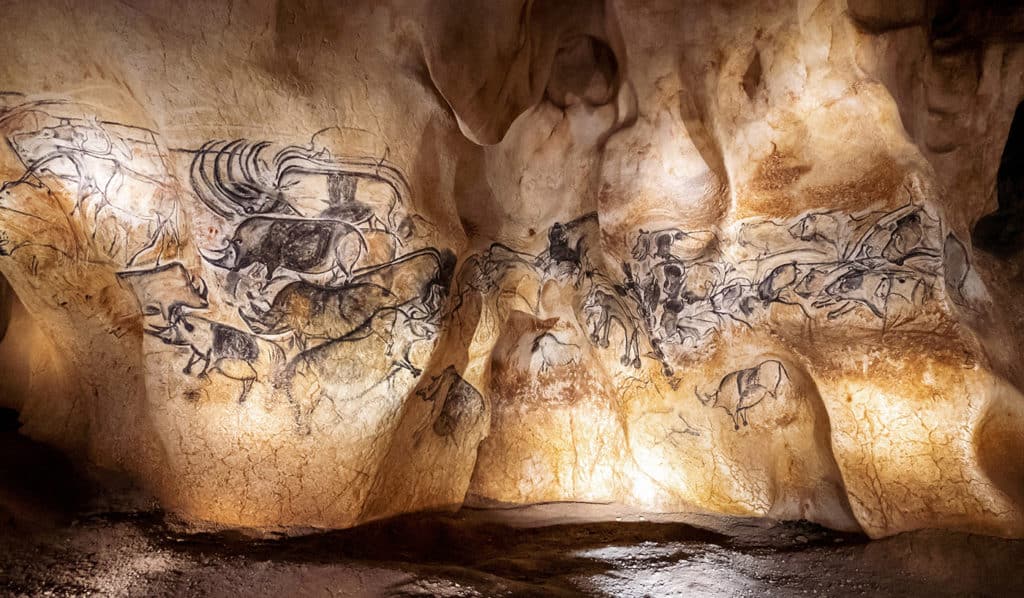
Some 200 skulls of cave bears have also been found in the cave. These bears died here naturally and stayed at Chauvet intermittently with humans.
Visit the Chauvet cave
As you can see, you are not allowed to visit the original cave. On the other hand, the replica is open to all, all year round .
You should allow ½ day to visit the whole site because more than just the cave, Chauvet 2 also offers an interpretation centre to better understand who the men were who left us this wonderful heritage and the environment in which they lived.
Chauvet 2 also offers animations around cave art for families and, this year, a sound and light show called “Animals” takes you from prehistory to street art!
Explore the Chauvet cave virtually
If you can’t make it to the cave, the French Ministry of Culture offers a virtual visit available free of charge on the website archeologie.culture.fr
Useful information
Adress: Grotte Chauvet 2 Ardèche 4941 Route de Bourg Saint Andéol 07150 Vallon Pont d’Arc (France)
Opening hours: Opening hours vary according to the season, check the cave’s website
Website: https://en.grottechauvet2ardeche.com/
Price: Adults: €17 10-17 years old: €8.5 Free for children under 10 years old
No Comments
Your email address will not be published. Required fields are marked *
Post comment Loading
This site uses Akismet to reduce spam. Learn how your comment data is processed .

Abonnez-vous à la Newsletter
Chaque mois, recevez le meilleur de Culturez-vous dans votre boite mail !
Merci ! Consultez votre boite mail pour valider votre inscription.
13 Facts About the Chauvet Cave Paintings
By kat long | may 17, 2019.
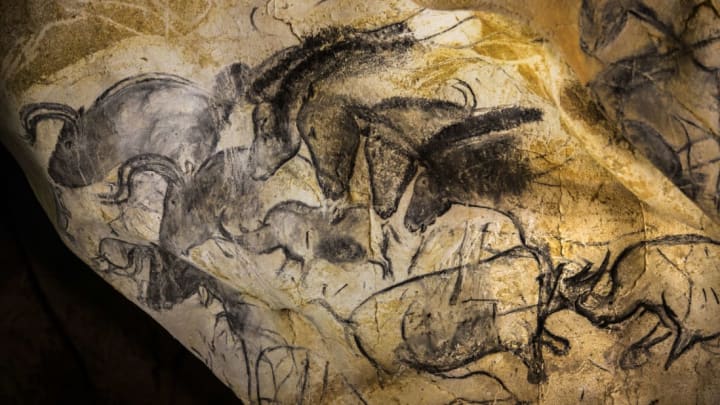
Discovered by accident in 1994, the cave paintings adorning the walls of Chauvet Cave in France are among the oldest and most beautiful figurative art in human history. About 36,000 years ago, the ancient artists drew lifelike beasts that seem to gallop, crawl, and frolic through the cave’s chambers. In one stunning triptych, 50 drawings of horses , lions, and reindeer cavort across 49 feet of limestone wall. The cave paintings even impressed filmmaker Werner Herzog enough to make a documentary (available on Netflix ). Here are a few more facts about the Chauvet Cave paintings.
1. The Chauvet Cave paintings were discovered by three local explorers.
It was December 18, 1994. French cavers Jean-Marie Chauvet, Éliette Brunel Deschamps, and Christian Hillaire had spent the day exploring the Pont d’Arc caves in the Ardèche region in southern France. They came upon an array of fallen rocks and noticed a gentle woosh of air from beneath the rock pile. Prying aside the stones, they found an aperture and dropped down into a large chamber with a high ceiling that appeared to branch off into other chambers. Their headlamps illuminated several handprints and a red ochre painting of a mammoth on the wall of one chamber. At that moment, they knew they had stumbled onto a major archaeological discovery.
2. Chauvet Cave was formed by an underground river.
Subterranean rivers flowing through the area's limestone hills created Chauvet Cave, along with hundreds of other gorges and caverns in the Ardèche. Chauvet Cave is about 1300 feet (roughly a quarter-mile) long with 14 chambers branching off the largest room, the Chamber of the Bear Hollows—the first one discovered by Chauvet, Brunel Deschamps, and Hillaire. This chamber, closest to the entrance, features no cave paintings; flooding is thought to have washed away any artwork. The most decorated vestibules are farthest from the entrance and include the Hillaire Chamber, Red Panels Gallery, Skull Chamber, the Megaloceros Gallery, and the End Chamber.
3. The Chauvet Cave painters were Aurignacians.
Aurignacians , the first anatomically modern humans in Europe, lived during the Upper Paleolithic, or Old Stone Age, between 46,000 and 26,000 years ago. ( Aurignacian also refers to this time period.) Aurignacian culture is characterized by the first figurative drawings and carvings, the invention of a flaked stone tool called a burin used for engraving, bone and antler tools, jewelry, and the oldest-known musical instruments.
In addition to the Chauvet Cave paintings, Aurignacian animal and human figurines have been found in other parts of Europe. At the Hohle Fels cave in southwestern Germany, archaeologists discovered the oldest known Venus statuette , dating from 40,000 to 35,000 years ago, and some of the oldest known bone flutes from the same time period. In Southeast Asia, a cave in Borneo bears the oldest known figurative painting, created at least 40,000 years ago.
4. Ancient humans visited Chauvet Cave during two separate millennia.
According to paleontologist Michel-Alain Garcia in Chauvet Cave : The Art of Earliest Times , radiocarbon dating of organic materials in Chauvet Cave suggest people used the cave during two different time periods . In the first, about 36,500 years ago during the Aurignacian, artists drew the majority of the Chauvet Cave paintings. They brought wood into the cave and burned it to create light and charcoal for drawing. Then, for an unknown reason, the Aurignacians abandoned the cave for about five or six thousand years, and it was taken over by cave bears. In the second instance of human use, about 31,000 to 30,000 years ago in the Gravettian period, humans left behind footprints, scorch marks from torches, and charcoal, but no artwork.
5. Fourteen animal species are represented in the Chauvet Cave paintings.
The most common animals in the Chauvet Cave paintings are cave lions, mammoths, and woolly rhinoceroses; all coexisted with the Aurignacians in Europe, but are now extinct. Along with depictions of cave bears , the four species make up 65 percent of the species in the paintings. The other are bison, horses, reindeer, red deer, ibex, aurochs (an extinct wild ancestor of domesticated cattle), the extinct Megaloceros deer (also called the Irish elk or giant deer), musk ox, panthers, and an owl. The paintings are notable for depicting not just figurative representations of the animals, but actual scenes that reveal the animals’ real behavior—like two woolly rhinoceroses butting horns, and a pride of lions stalking a group of bison.
6. Non-animal themes also pop up in Chauvet Cave paintings.
In the middle chambers of Chauvet Cave, several walls and overhanging rocks are decorated with red dots made by human palms and stencils of human hands. In the farthest galleries of the cave, five triangular representations of a woman’s pubic area are scratched on to the walls, and one picture of a woman’s lower body similar in profile to Paleolithic Venus figurines is drawn on a stalactite-like rock pendant. Anthropologists are not sure what they’re meant to symbolize.
7. A prehistoric child’s footprints were discovered in Chauvet Cave.
A single track of footprints measuring 230 feet long was found in the soft clay floor of the cave’s Gallery of the Crosshatching. Researchers analyzed modern European feet that were estimated to be roughly equivalent to those of European Early Modern Humans and determined that the track was probably made by a young boy about 4.5 feet tall. Scientists were able to date the prints based on the marks left by a burning torch on the roof of the gallery. “The child regularly wiped his torch on [the vault] above his path. These charcoal marks, dated to 26,000 years ago, seem to have been placed contrary to the direction of progress on purpose, as if to mark the way back,” Garcia writes. Two bits of charcoal were retrieved from the substrate and dated to a period between 31,430 years and 25,440 years ago.
8. The child might have had a pet dog.
The adolescent boy’s footprints are near those of a large canid—possibly a wolf. When Garcia took a closer look, he noticed the length of the middle digit was shorter than a wolf’s, a trait more typical of a domesticated dog . But in the 1990s, when Garcia made the find, the oldest undisputed fossil evidence of a domesticated dog dated back only 14,200 years before present.
A 2017 study that built on previous research, however, compared genomes of three Neolithic dogs with those of more than 5000 canines, including modern wolves and dogs. The researchers concluded that dogs and wolves split genetically sometime between 41,500 and 36,900 years ago, and a second divergence of eastern and western dogs occurred between 23,900 and 17,500 years ago. That puts the window of domestication between 40,000 and 20,000 years ago—the same time as the Aurignacian child and his very good boy were walking through Chauvet Cave.
9. Chauvet cave provided shelter for bears.
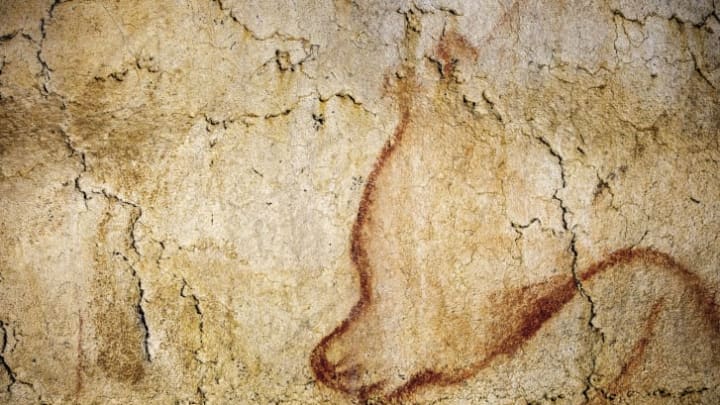
Larger than modern grizzlies, cave bears spent winters in Chauvet Cave for thousands of years before humans began painting in it. They left claw scratches on the walls and dozens of tracks and footprints in the floor. In the Chamber of the Bear Hollows, researchers have found more than 300 hollows (sleeping spots that bears wore into the cave floor) and dozens of bear tracks and paw prints, made after humans stopped visiting the cave. About 2500 cave bear bones and 170 skulls were scattered throughout the cave’s main chambers. When scientists first investigated the cave in the mid-1990s, they found a cave bear skull carefully placed on a large stone in the middle of a deep chamber, in a way that only humans could have done.
10. The cave also provided shelter for a lot of wolves.
The floor of the Brunel Chamber, directly south of the Chamber of the Bear Hollows, showed multiple wolf prints that indicated a large number of “fissipeds” (pad-footed carnivores) had trampled the ground. Bear prints were superimposed on the wolf prints, suggesting that the bears came in after the wolves.
Not only large carnivores occupied the cave—judging from the variety of bones, it was practically a prehistoric zoo. In addition to the wolf, ibex, and bear bones, prehistorian Jean Clottes reported finding those of foxes, martens (a kind of weasel), roe deer, horses, birds, rodents, bats, and reptiles. And, yes, he also found fossilized wolf poop, indicating the wolves probably went into the cave in search of carrion.
11. No one knows why the Chauvet Cave paintings were created.
The purpose behind the Chauvet Cave paintings is a mystery, but some characteristics of the artwork may offer clues. Researchers have noted that the primary species depicted—cave bear, lion, mammoth, and rhinoceros—were not prey species that Aurignacians pursued for food, possibly suggesting that the paintings weren’t meant to ensure bountiful hunting.
A 2016 study hinted that the Chauvet Cave artists may have been recording contemporary events. Jean-Michel Geneste and colleagues proposed that a spray-like design in the Megaloceros Gallery was a faithful depiction of a volcanic eruption that occurred in the nearby Bas-Vivaris region between 40,000 and 30,000 years ago. If that is true, Chauvet Cave boasts the oldest known painting of volcanic activity, smoking the previous record holder—a 9000-year-old mural in central Turkey—by 28,000 years.
12. When Werner Herzog entered Chauvet Cave, he was overwhelmed.
Filmmaker Werner Herzog accompanied researchers into the depths of the cave system to make his 2010 documentary Cave of Forgotten Dreams (available to stream on Netflix). Herzog’s grandfather was an archaeologist, and Herzog himself once earned money as a ball boy at a tennis court to buy a book about cave art. “Even though in a way I knew what was waiting for me because I had seen photos, I was in complete and overwhelming awe,” Herzog told The A.V. Club in 2011. “The mysterious origins of it—we don’t know why they were made, and why in complete darkness and not next to the entrance.”
13. You can visit a scale replica of the Chauvet Cave paintings.
The world-famous Paleolithic cave paintings at Lascaux, not far from Pont d’Arc, were damaged by the exhalations of thousands of visitors after the cave was opened to the public in 1948. So, immediately after Chauvet Cave was discovered, scientists moved to protect the fragile paintings and closed it to the public; now, only scholars are allowed in during brief windows of time. But that doesn’t mean you can’t see a simulation of the artwork up close. In 2015, a scale replica of the Chauvet Cave paintings, dubbed the Caverne du Pont d’Arc, opened near the site of the actual cave. Engineers and artists faithfully recreated not just the dazzling paintings, but also the temperature, dampness, murk, and funky smell of the original.
Type your search and press enter
- Mes favoris 0
Chauvet 2 Cave
Journey back 36,000 years, to the origins of art..
Chauvet Cave was discovered in 1994 and is a cave covered in prehistoric drawings, over 36,000 years old.
There are 425 drawings and paintings, including exceptional representations of animals (twice as old as those in Lascaux!), Chauvet Cave is actually the most ancient example of art in the whole of Humanity .
In 2014, it was listed as a Worldwide Heritage site by UNESCO .

Chauvet 2, the replica
It’s important to know that it’s not the real cave that you’re going to visit, but an exact copy.
The original cave is now closed to the public (for obvious conservation reasons).
So that everyone can still discover the superb artwork, Chauvet 2 Cave was created.
The representations, walls and floors, ceilings and archaeological remains of the original cave have been reproduced as an identical copy.
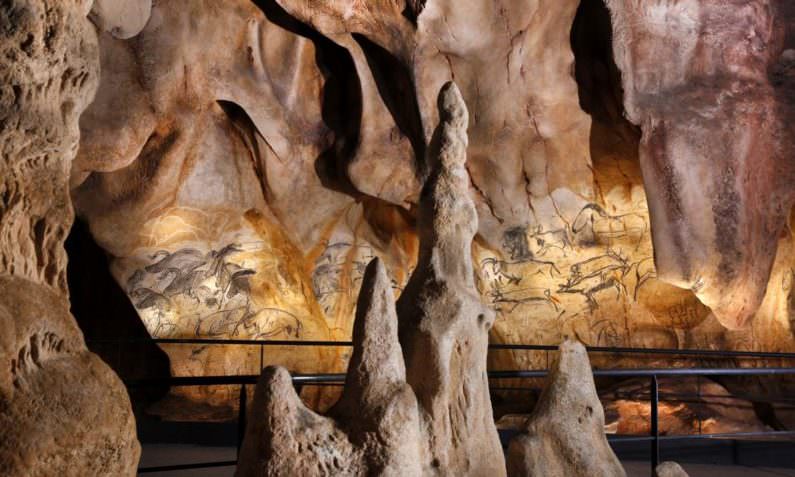
Practical information
The cave can be found in Vallon-Pont-d’Arc. It is open every day, all year round .
Ticket price: Adults: from €17 Young people (10 to 17 years old): €8.50 Children under 10: free Annual pass: €25 / year
With your entrance ticket, you have access to the guided tour of Chauvet 2 Cave (approx. 1 hour), and also a self-guided tour of the Aurignacien Gallery , a fun and interactive area to find out about the prehistoric men who drew on the walls of Chauvet Cave and how they lived. Altogether, you will need half a day there.
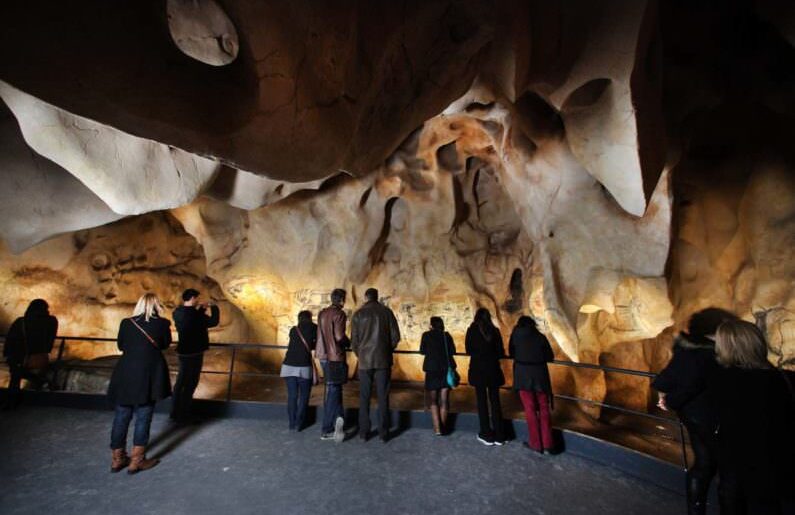
The Aurignacien Gallery
But who were our prehistoric ancestors? Where did they come from? How did they live? After seeing Chauvet 2 Cave with your own eyes, come and learn all about it. At the The Aurignacien Gallery you can learn all about these men and women who lived 360 centuries ago, and have fun at the same time.
Take a stroll through the recreation of the steppes, where you will encounter the terrifying cave lion, the impressive Irish elk or even the woolly mammoth.
You will find out all about the environment and the wildlife which surrounded our closest homo-sapien ancestors.
Immersive films, touch screens, themed areas, workshops and entertainment for children during the school holidays.

Heilbrunn Timeline of Art History Essays
Chauvet cave (ca. 30,000 b.c.).
Jean Clottes Independent Scholar
October 2002
The Chauvet Cave was discovered in the Ardèche valley (in southern France) in December 1994 by three cave explorers, after removing the rumble of stones that blocked a passage.
The cave is extensive, about 400 meters long, with vast chambers. The floor of the cave is littered with archaeological and palaeontological remains, including the skulls and bones of cave bears , which hibernated there, along with the skulls of an ibex and two wolves. The cave bears also left innumerable scratches on the walls and footprints on the ground.
The two major parts of the cave were used in different ways by artists. In the first part, a majority of images are red, with few black or engraved ones. In the second part, the animals are mostly black, with far fewer engravings and red figures. Obvious concentrations of images occur in certain places. The most spectacular images are the Horse Panel and the Panel of Lions and Rhinoceroses.
The dominant animals throughout the cave are lions , mammoths, and rhinoceroses. From the archaeological record, it is clear that these animals were rarely hunted; the images are thus not simple depictions of daily life at the time they were made. Along with cave bears (which were far larger than grizzly bears), the lions, mammoths, and rhinos account for 63 percent of the identified animals, a huge percentage compared to later periods of cave art. Horses, bison, ibex, reindeer, red deer, aurochs, Megaceros deer, musk-oxen, panther, and owl are also represented. An exceptional image of the lower body of a woman was found associated with a bison figure. Many images of large red dots are, indeed, partial handprints made with the palm of the hand. Red hand stencils and complete handprints have also been discovered.
Thirty radiocarbon datings made in the cave have shown that it was frequented at two different periods. Most of the images were drawn during the first period, between 30,000 and 32,000 BP in radiocarbon years. Some people came back between 25,000 to 27,000 and left torch marks and charcoal on the ground. Some human footprints belonging to a child may date back to the second period.
Clottes, Jean. “Chauvet Cave (ca. 30,000 B.C.) .” In Heilbrunn Timeline of Art History . New York: The Metropolitan Museum of Art, 2000–. http://www.metmuseum.org/toah/hd/chav/hd_chav.htm (October 2002)
Related Essays
- Introduction to Prehistoric Art, 20,000–8000 B.C.
- Lascaux (ca. 15,000 B.C.)
- African Rock Art
- Apollo 11 (ca. 25,500–23,500 B.C.) and Wonderwerk (ca. 8000 B.C.) Cave Stones
- Blackwater Draw (ca. 9500–3000 B.C.)
- Eynan/Ain Mallaha (12,500–10,000 B.C.)
- Fell’s Cave (9000–8000 B.C.)
- Jiahu (ca. 7000–5700 B.C.)
- Jōmon Culture (ca. 10,500–ca. 300 B.C.)
- Mal’ta (ca. 20,000 B.C.)
- Neolithic Period in China
- Pachmari Hills (ca. 9000–3000 B.C.)
- Ubirr (ca. 40,000?–present)
- Wadi Kubbaniya (ca. 17,000–15,000 B.C.)
- Archaeology
- Prehistoric Art
Grotte Chauvet: Journey through time with France’s oldest cave paintings
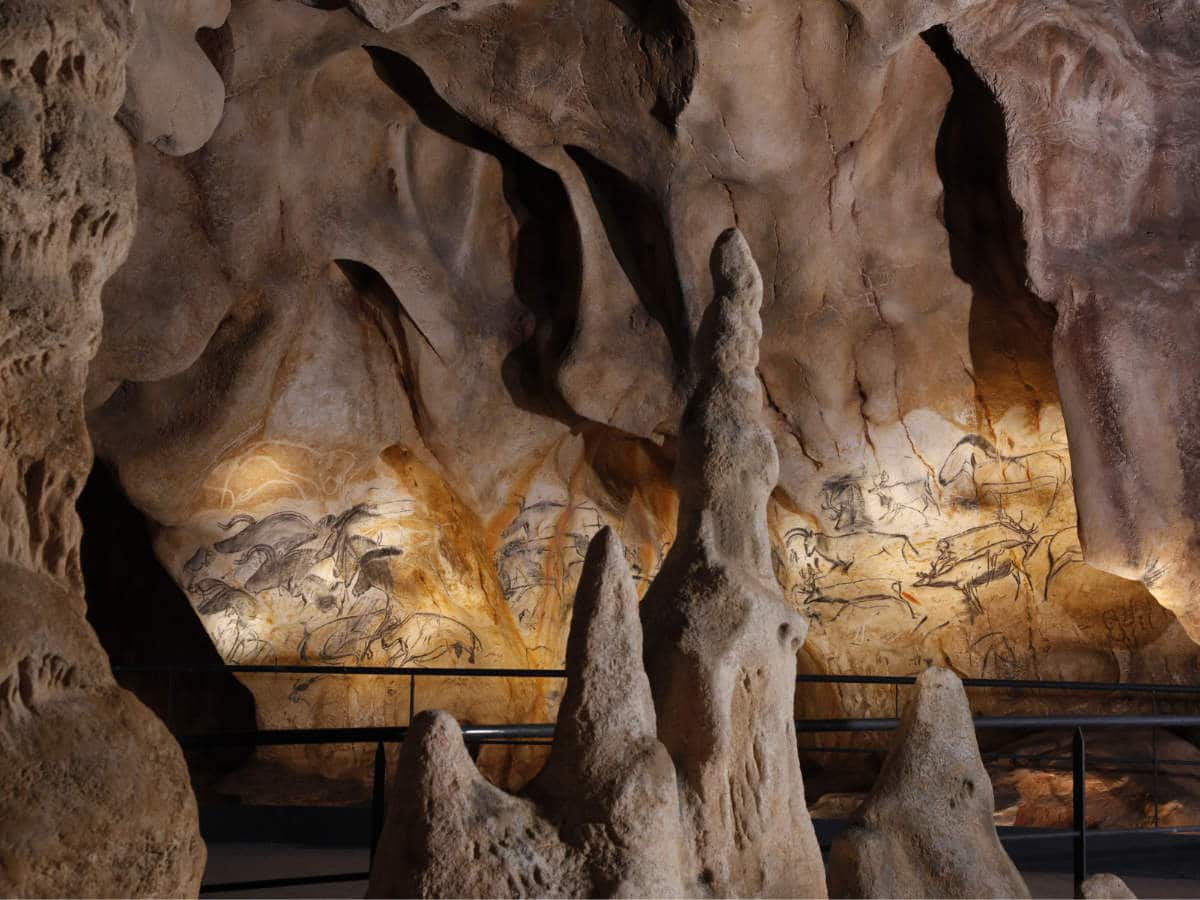
- Post category: Auvergne Rhône Alpes
- Post author: Nassie Angadi
One of the greatest cultural treasures in the world is located in the heart of department of Ardèche, in the center of France.
Known as Grotte Chauvet (Cave Chauvet), it is a cave network which is famous for having some of the earliest known Palaeolithic human cave paintings. Dating back about 28,000 – 32,000 years old, these are among the oldest in the world.
A cave complex near the village of Vallon-Pont-d’Arc, it was discovered on December 18, 1994 after a group of cavers entered the cave and noticed everything from handprints, engravings, and drawings of a variety of animals on the walls of the cave.
Located within a couple of hours of the cities of Lyon , Avignon , and Valence in the Rhône Alps region, the Chauvet-Pont-d’Arc Cave complex is truly one of the most spectacular archeological and anthropological sites in existence.
Today, it is officially recognized on the UNESCO world heritage list . And it is one of the most popular tourist attractions in France .
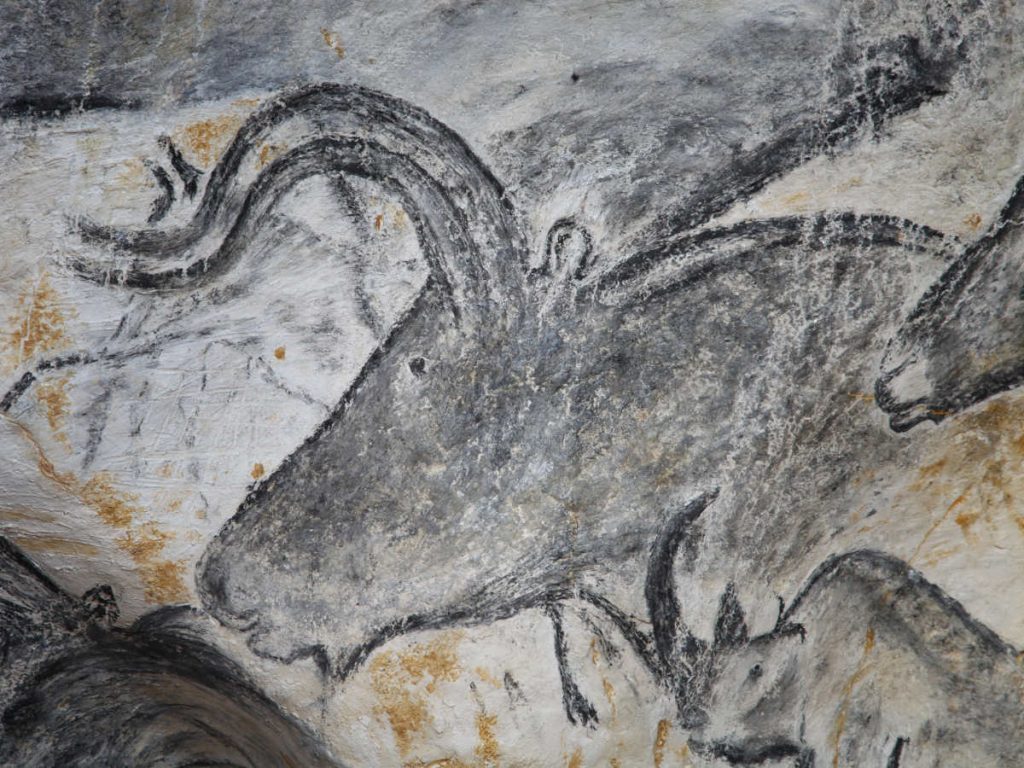
There are several panels with some of the earliest known figurative drawings, making it one of the most important prehistoric art sites in the world. These spectacular images were created by prehistoric humans, or Homo sapiens, as they roamed the European continent.
Its discovery on December 18, 1994, by three spelunkers, Jean-Marie Chauvet, Eliette Brunel-Deschamps, and Christian Hillaire made headlines around the world.
Now, if you do look for it, you might notice that it is called “Grotte Chauvet 2”, and not just “Grotte Chauvet”. That is because the actual cave is too fragile to allow visitors.
Grotte Chauvet 2 is an exact replica of the original cave that has been built to educate visitors about life in the Paleolithic era. If you look on Google Maps or on your GPS, you will see both locations, with one of them marked as “not accessible”.
So is Grotte Chauvet 2 actually worth the visit, if it is not the original? Let’s find out more, shall we? Allons-y!
3. Other Animations
Why the original grotte chauvet is not open to tourists.
In order to understand why the original Grotte Chauvet is not open to the public, we have to reference another famous set of prehistoric cave paintings in France, la Grotte de Lascaux .
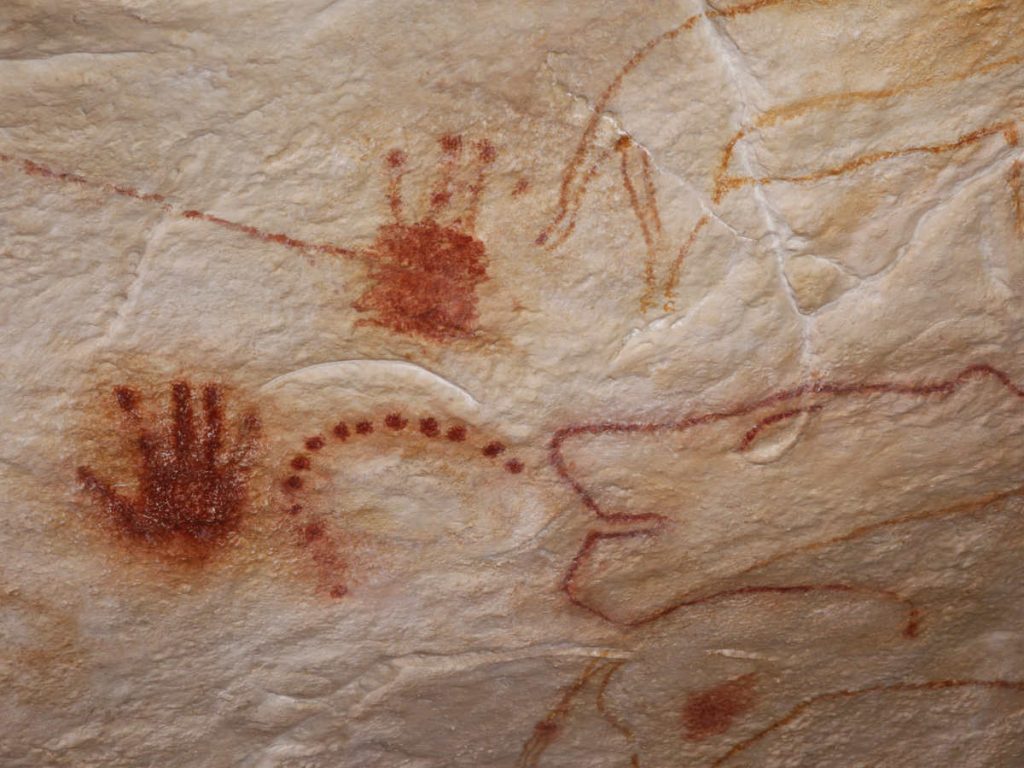
The Lascaux cave was discovered in 1940 by four teenagers near the town of Montignac, in Dordogne, France. With paintings dating back to 17,000 years , it was visited by millions of visitors, before being closed to the public in 1963. But an irreversible cycle of decay had begun.
Fungus, which cannot be removed, now covers many of the paintings at Lascaux. The carbon dioxide caused by the breath of the tourists caused the additional moisture, which has now washed away many of the pigments and turned the walls grey.
A celebration meant for the 70th anniversary of the discovery of the Grotte de la Lascaux, was likened to a “funeral service”.
And this is why when Grotte Chauvet was discovered in 1994, French authorities immediately swooped in to protect the cave. Especially since the Chauvet cave paintings are estimated to be almost twice as old as Lascaux, at 32,000 years old.
(When another cave called Grotte Cosquer in Marseille was found in 1991, access was also immediately limited.)

What to see at Grotte Chauvet 2
The original Chauvet cave is located along the Gorges de l’Ardèche , while the replica Grotte Chauvet 2 is located around 6miles (10km) away in a rather modern complex.
Along with the cave itself, there are several other things to visit around the exhibition.
1. Inside Chauvet Cave 2
The Grotte Chauvet 2 is also considered quite fragile, and is also only visitable in small guided tours. Photos are not allowed inside the cave.
Inside, you will see tens of small animal paintings, depicting at least 13 different species. There is everything from horses, lions, leapards, and rhinos to mammoths, etc. and other animals from the prehistoric era.
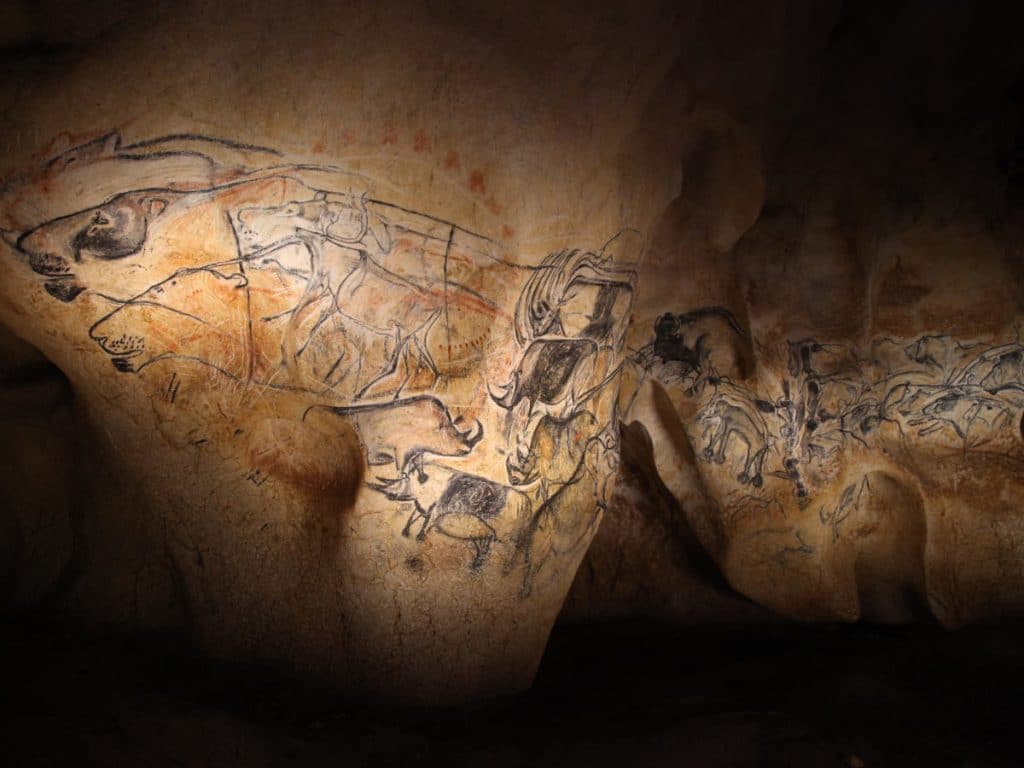
There are also palm and handprints, attesting to the intelligence of those earliest homo-sapiens. Of note is a particular handprint with a crooked finger, who by all accounts was quite the artist as his/her work can be identified in several areas of the cave.
Many of the animals have been sketched and carved as if in motion, showing the artists’ keen sense of observation and acuity. The age of the original cave paintings is based on over 80 radiocarbon samples taken for dating, indicating that some of the paintings date back to 35-30,000 years.
The cave is named after one of the explorers, Jean-Marie Chauvet, but that also is not without controversy. The original hole entrance to the cave was found by a man named Michael Rosa (known as “Baba”) and became known as Le Trou de Baba , or Baba’s Hole.
According to reports , a decision was made to come back later, when Chauvet came back without him. In the end, it would be Chauvet who had his name attached to one of the world’s greatest treasures, while Michael Rosa remains quite unknown.
2. Aurignacian Gallery
In addition to the main cave, there is also an educational exhibition called the Aurignacian Gallery.
With life-size models of the earliest humans as well as ice age creatures like the wooly mammoth, there are several knowledge panels for visitors to read and explore.
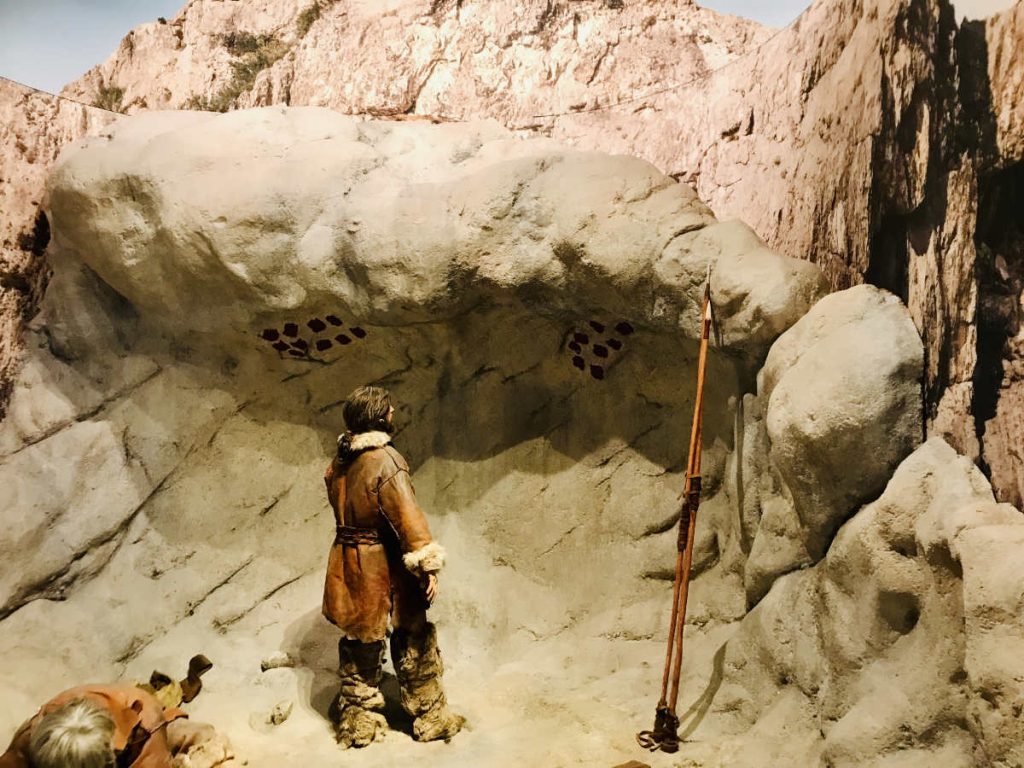
The exhibition indicates it should take around an 1 hour to get through the exhibit, although if you go with small children who can’t read (like I did), it will be much quicker!
If you visit during the summer tourist season, you will find several knowledgeable guides around the Grotte Chauvet 2 complex.
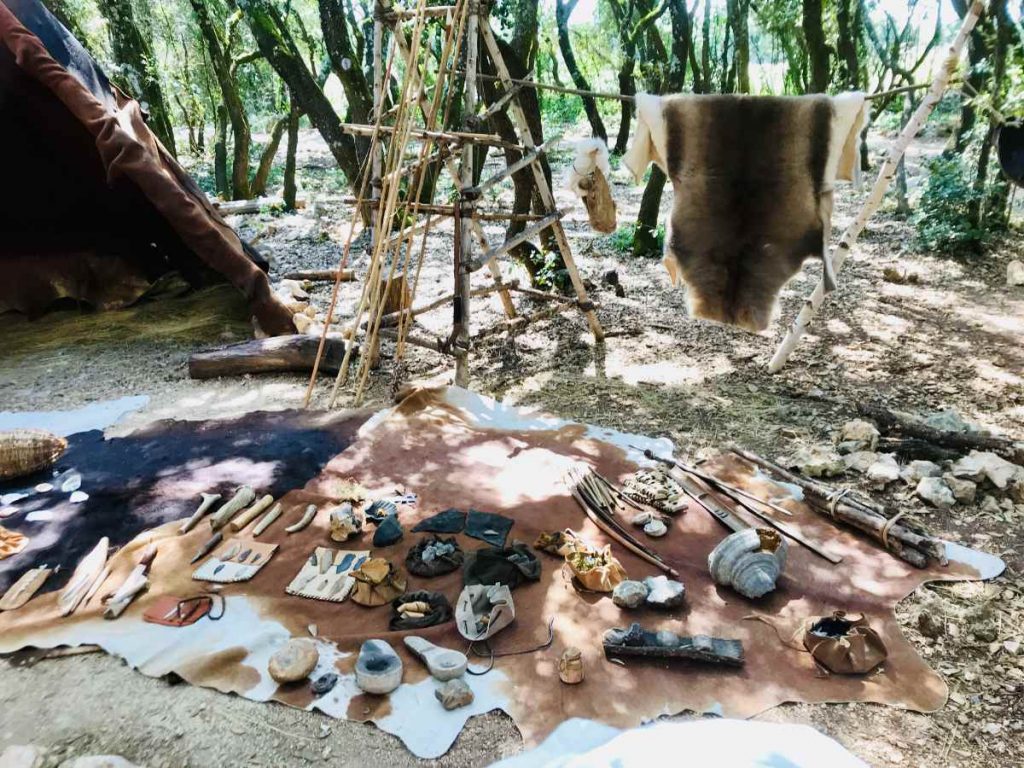
Displaying replica artifacts of human tools, the guides discuss at length what life was like in the Paleolithic and Stone Age era.
What they ate, how they hunted, what they wore, etc., the guides give plenty of insight on what it must have been like for those cave artists.
Preparation tips for your visit
The cave at Grotte Chauvet 2 is kept at cool temperatures, to replicate the original as much as possible. A light sweater or jacket is recommended, especially for small children.
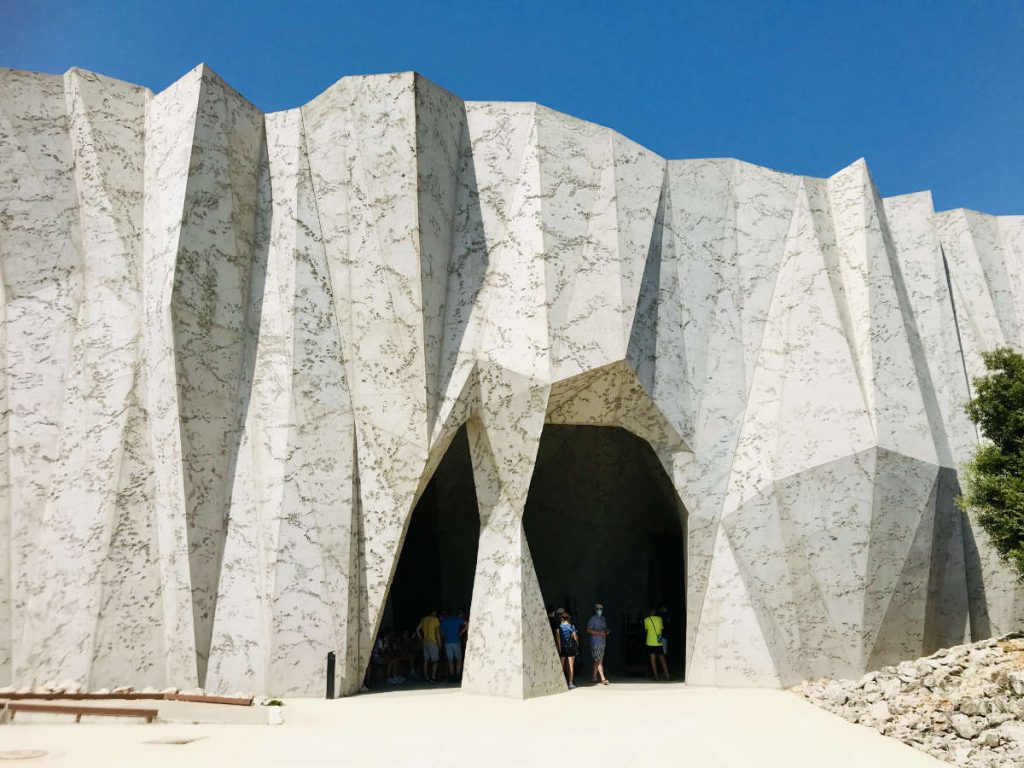
Access to the cave is based on timed-entry, so it is important to be there on time. If you do arrive too early, you can visit the other animations and the Aurignacian Gallery beforehand. (The Aurignacian Gallery takes around 45 minutes so plan accordingly.)
It is around a 5-10 minute walk uphill towards the entrance of the premises to the building entrance, depending on if you are heading over with strollers and small children, etc.
Tickets cost around €17/adult and €8.50/child over 10 years old. Children under 10 are free. Most of the Grotte Chauvet 2 complex is quite accessible for strollers and wheelchairs, but it can get crowded.
Pont d’Arc and other sights nearby
Located about 600 yards (550m) away from the original Chauvet Cave, is the Pont d’Arc, a natural bridge created by the water flows of the Ardèche river flowing through the Gorges de l’Ardèche.
It is about 6 miles (10 km) away from the replica at Grotte Chauvet 2, and a popular destination for bathers, kayakers, and hikers who wish the enjoy a bit of nature.
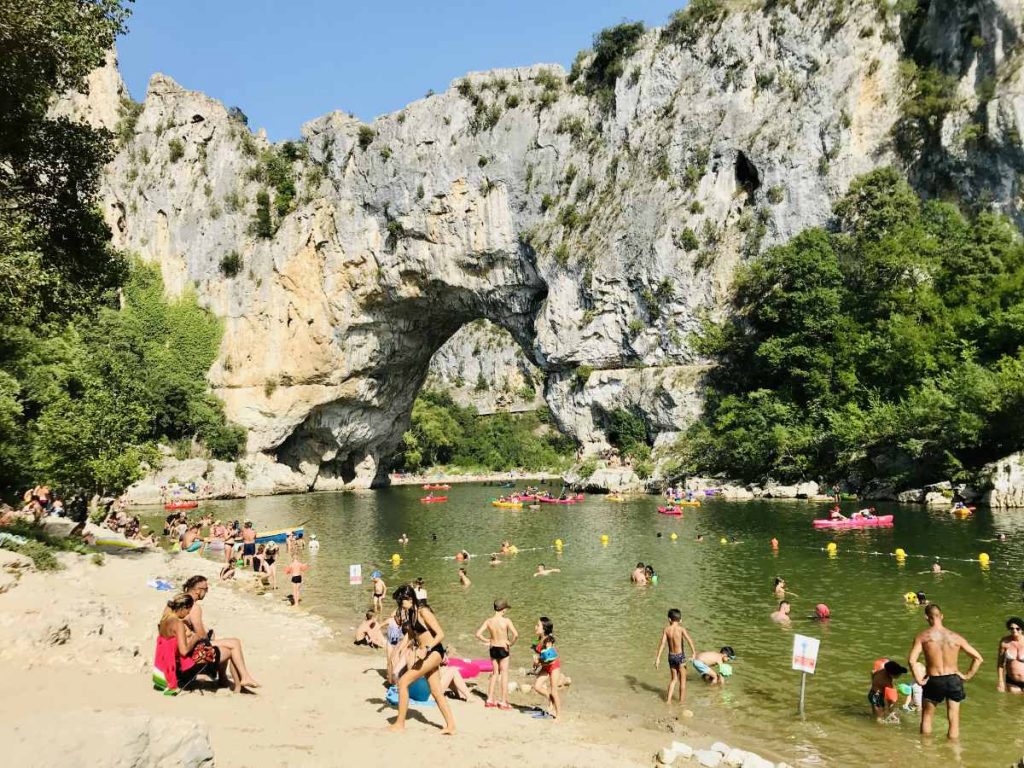
The natural arch of the Pont d’Arc was formed around 124,000 years ago, by the effect of erosion in the limestone rock. Given the many decorated caves in this area, it is thought that this natural bridge would have frequented by homosapiens (also known as Cro-Magnon or Aurignacian) since at least the Paleolithic era.
It is known to have served part of the Romaine d’Antonin , an old Roman road in the 2nd century that connected the old Roman cities of Nîmes and Valence.
In addition, the Grotte Chauvet 2 is relatively close by to another famous cave in the area, the Grotte de Choranche . The large cities of Lyon, Grenoble , and Vienne are also easily accessible, so you can easily make the trip to visit there as well.
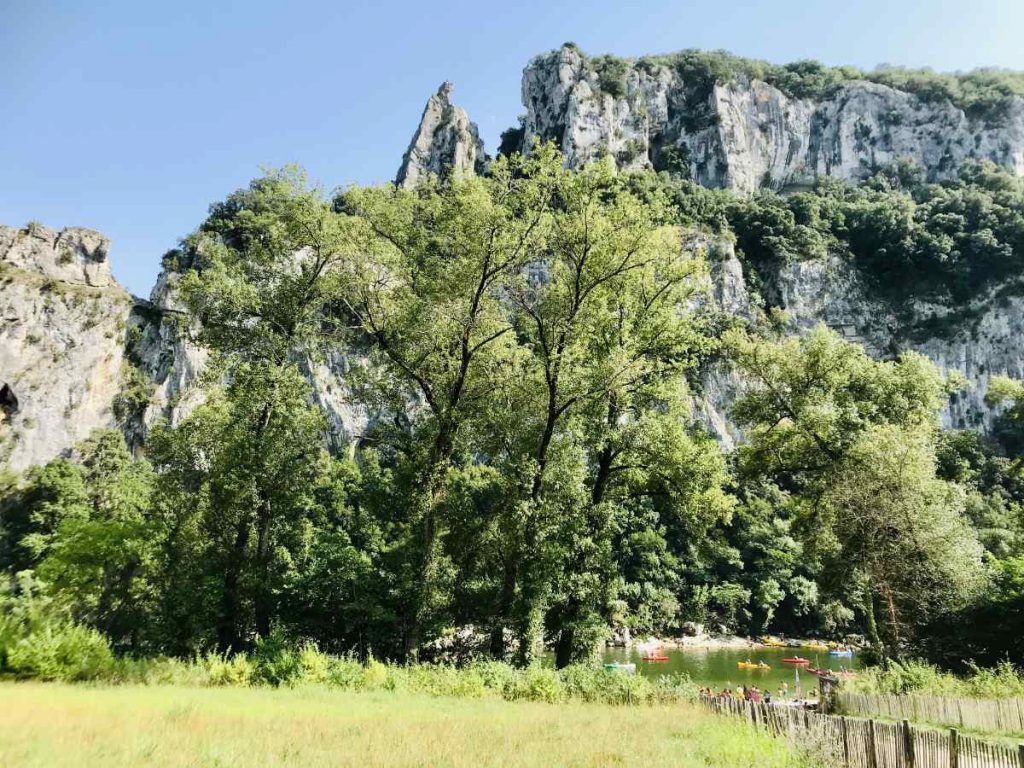
How to get to Grotte Chauvet 2?
The Grotte Chauvet 2 is only accessible by car, with the closest train station in the nearby town of Pierrelatte about 20 miles (33km) away.
If you are driving , one thing to play close attention to is that you should program “Grotte Chauvet 2” on your GPS. Both will show up on your GPS, and they are not within walkable distance, so you really want to be sure to program the address of the correct one.
How long does the visit take?
The guided tour inside the Chauvet cave takes about 1 hour. However, plan to arrive at least 15 minutes in advance from the parking lot to pass through the entrance, and to the actual cave entrance to be on time with your tour guide.
In addition, the Aurignacian Gallery should take about 45min-1 hour to visit. There are also often animations by knowledgeable guides in the park area discussing human life in that era, so you will want to keep that in mind as well, during your planning.
If you enjoyed that article, you may like to read more about traveling around the region of Auvergne-Rhône-Alps . A bientôt!
¹ Featured Images and Cave images: © Patrick Aventurier – Grotte Chauvet 2 Ardèche
You Might Also Like

UCPA ski: Mountain holidays without the headache of planning

Lyon: Art, history and cuisine in France’s 3rd largest city

UCPA Family ski: Slopes & smiles at the ultimate all-inclusive holiday

Montélimar: Embracing nature and nougat-making in small town France
Leave a reply cancel reply.
- Paris & Île-de-France
- Alsace & Lorraine
- Bourgogne-Franche-Comté
- Bretagne & Normandy
- Auvergne Rhône Alpes
- Loire Valley
- Northern France
- Nouvelle Aquitaine
- Provence & French Riviera
- Common Questions
- Living in France
- French Parenting
- French Holidays
- French Language
- French Etiquette
- French Music
- Moving to France
- Facts and history
- Appetizers & Starters
- Main dishes
- Side dishes
- Get the Look
- Newsletter archives
Finally, the Beauty of France’s Chauvet Cave Makes its Grand Public Debut
A high-tech recreation of the immortal artworks shines a new light on the dawn of human imagination
/https://tf-cmsv2-smithsonianmag-media.s3.amazonaws.com/accounts/headshot/Screen_Shot_2021-09-15_at_12.44.05_PM.png)
Joshua Hammer
Contributing writer
/https://tf-cmsv2-smithsonianmag-media.s3.amazonaws.com/filer/75/9d/759d0831-61fc-4e60-b7d8-25cf7441cea8/apr2015_h03_chauvetcave.jpg)
As I descend a footpath through subterranean gloom, limestone walls tower 40 feet and plunge into a chasm. Gleaming stalactites dangle from the ceiling. After several twists and turns, I reach a cul-de-sac. As I shine my iPhone flashlight on the walls, out of the darkness emerge drawings in charcoal and red ocher of woolly rhinos, mammoths and other mammals that began to die out during the Pleistocene era, about 10,000 years ago.
It feels, and even smells, like a journey into a deep hole in the earth. But this excursion is actually taking place in a giant concrete shed set in the pine-forested hills of the Ardèche Gorge in southern France. The rock walls are stone-colored mortar molded over metal scaffolding; the stalactites were fashioned from plastic and paint in a Paris atelier. Some of the wall paintings are the work of my guide, Alain Dalis, and the team of fellow artists at his studio, Arc et Os, in Montignac, north of
Toulouse. Dalis pauses before a panel depicting a pride of lions in profile, sketched with charcoal. “These were drawn on polystyrene, a synthetic resin, then fitted to the wall,” he tells me. The result is a precise, transfixing replica of the End Chamber, also called the Gallery of Lions, inside the actual Chauvet Cave, located three miles from here and widely viewed as the world’s greatest repository of Upper Paleolithic art.
The $62.5 million facsimile is called the Caverne du Pont d’Arc, after a nearby landmark—a natural archway of eroded limestone spanning the Ardèche River and known to humans since Paleolithic times. The replica, opening to the public this month, has been in the works since 2007, when the Ardèche departmental government, recognizing that an international audience was clamoring to view the cave, decided to join with other public and private funders to build a simulacrum. Restrictions imposed by the French Ministry of Culture bar all but scientists and other researchers from the fragile environment of the cave itself.
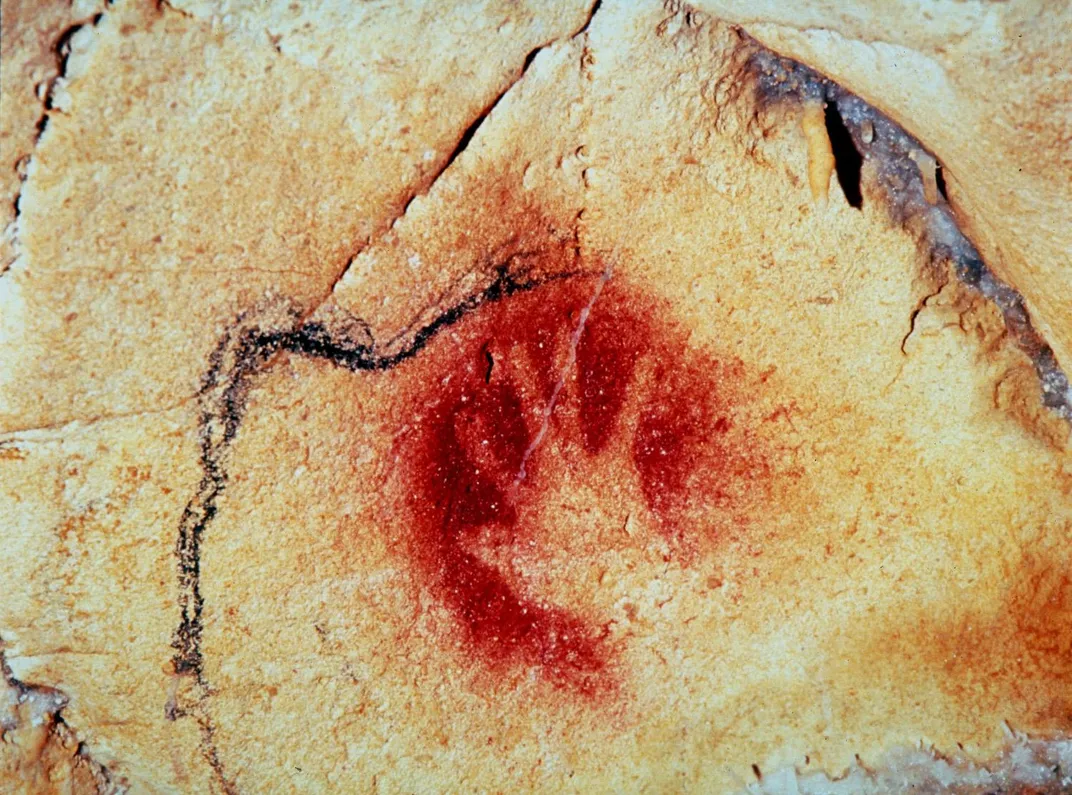
Five hundred people—including artists and engineers, architects and special-effects designers—collaborated on the project, using 3-D computer mapping, high-resolution scans and photographs to recreate the textures and colors of the cave. “This is the biggest project of its kind in the world,” declares Pascal Terrasse, the president of the Caverne du Pont d’Arc project and a deputy to the National Assembly from Ardèche. “We made this ambitious choice... so that everybody can admire these exceptional, but forever inaccessible treasures.”
The simulated cavern is not only a stunning tribute to a place, but also to a moment. It celebrates the cold afternoon in December 1994 when three friends and weekend cavers—Jean-Marie Chauvet, Eliette Brunel and Christian Hillaire—followed an air current into an aperture in a limestone cliff, tunneled their way through a narrow passage, using hammers and awls to chip away at the rocks and stalactites that blocked their progress, and descended into a world frozen in time—its main entrance blocked off by a massive rock slide 29,000 years ago. Brunel, the first to wedge through the passage, glimpsed surreal crystalline deposits that had built up for millennia, then stopped before a pair of blurry red lines drawn on the wall to her right. “They have been here,” she shouted to her awe-struck companions.
The trio moved gingerly across the earthen floor, trying not to tread on the crystallized ashes from an ancient fire pit, gazing in wonder at hundreds of images. “We found ourselves in front of a rock wall covered entirely with red ocher drawings,” the cavers remembered in their brief memoir published last year. “The panel contained a mammoth with a long trunk, then a lion with red dots spattered around its snout in an arc, like drops of blood. We crouched on our heels, gazing at the cave wall, mute with stupefaction.”
Spread out over six chambers spanning 1,300 feet were panels of lionesses in pursuit of great herbivores—including aurochs, the now-extinct ancestors of domestic cattle, and bison; engravings of owls and woolly rhinoceroses; a charcoal portrait of four wild horses captured in individualized profile, and some 400 other images of beasts that had roamed the plains and valleys in huge numbers during the ice age. With a skill never before seen in cave art, the artists had used the knobs, recesses and other irregularities of the limestone to impart a sense of dynamism and three-dimensionality to their galloping, leaping creatures. Later, Jean-Marie Chauvet would marvel at the “remarkable realism” and “aesthetic mastery” of the artworks they encountered that day.
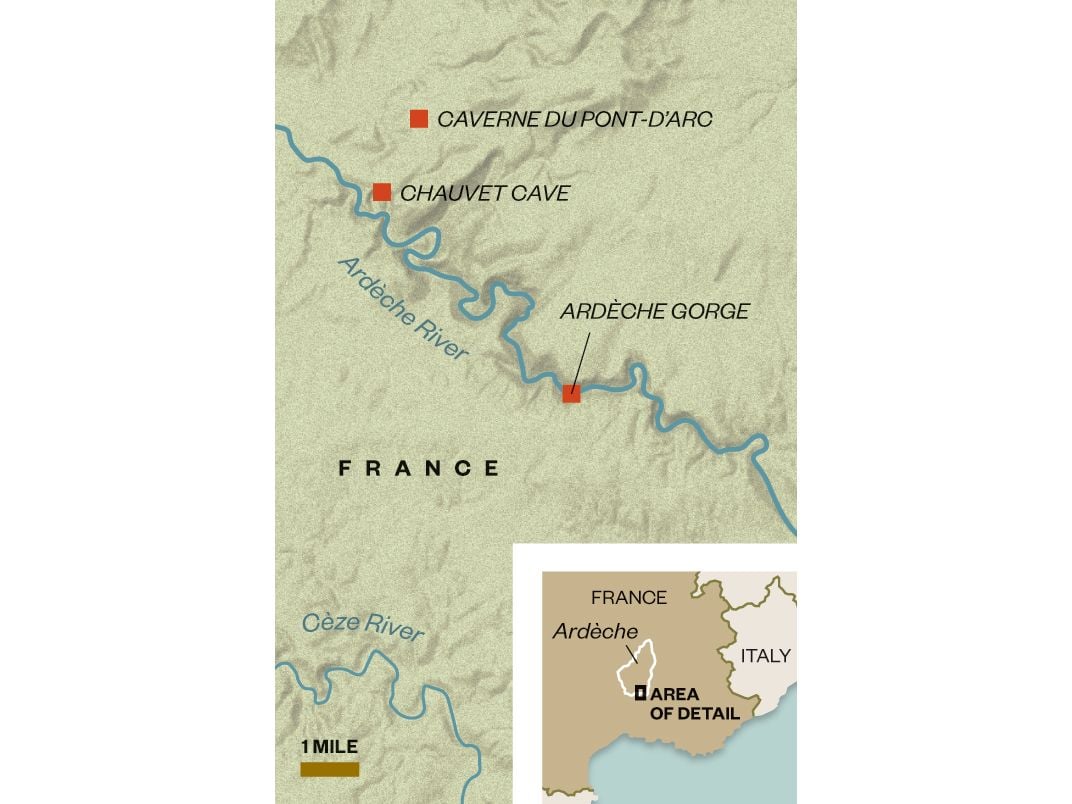
Within months, Chauvet (the cave, officially Chauvet-Pont d’Arc, was named for its primary discoverer) would revolutionize our understanding of emerging human creativity. Radiocarbon dating conducted on 80 charcoal samples from the paintings determined that the majority of the works dated back 36,000 years—more than double the age of any comparable cave art yet uncovered. A second wave of Paleolithic artists, scientists would determine, entered the cave 5,000 years later and added dozens more paintings to the walls. Researchers were compelled to radically revise their estimates of the period when Homo sapiens first developed symbolic art and began to unleash the power of imagination. At the height of the Aurignacian period—between 40,000 and 28,000 years ago—when Homo sapiens shared the turf with the still-dominant Neanderthals, this artistic impulse may have signaled an evolutionary leap. While Homo sapiens were experimenting with perspective and creating proto-animation on the walls, their cousins, the Neanderthals, shuffling toward extinction, had not moved beyond the production of crude rings and awls. The finding also demonstrated that Paleolithic artists had painted in a consistent style, using similar techniques for 25,000 years—a remarkable stability that is the sign, Gregory Curtis wrote in The Cave Painters , his major survey of prehistoric art, of “a classical civilization.”
The Caverne du Pont d’Arc installation is the product of a bitter experience involving another irreplaceable treasure. The Lascaux Cave in the Dordogne region of southwestern France was, like Chauvet, discovered by serendipity: In September 1940, four teenage boys and their dog stumbled across it while searching for rumored buried treasure in the forest. The 650-foot-long subterranean complex contains 900 of the finest examples of prehistoric paintings and engravings ever seen, all dating back around 17,000 years. The cave’s undoing came after the French Ministry of Culture opened it to the public in 1948: Visitors by the thousands rushed in, destroying the fragile atmospheric equilibrium. A green slime of bacteria, fungi and algae formed on the walls; white-crystal deposits coated the frescoes. In 1963 alarmed officials sealed the cave and limited entry to scientists and other experts. But an irreversible cycle of decay had begun. Spreading fungus lesions—which cannot be removed without causing further damage—now cover many of the paintings. Moisture has washed away pigments and turned the white calcite walls a dull gray. In 2010, when then French President Nicolas Sarkozy and his wife, Carla Bruni-Sarkozy, toured the site on the 70th anniversary of its discovery, Laurence Léauté-Beasley, president of a committee that campaigns for the cave’s preservation, called the visit a “funeral service for Lascaux.”
Immediately upon Chauvet’s discovery—even before it was announced—French authorities installed a steel door at the entrance and imposed stringent access restrictions. In 2014, a total of 280 individuals—including scientists, specialists working on the simulation and conservators monitoring the cave—were allowed to enter, typically spending two hours in a single visit.
A few days after Christmas in 1994, Jean Clottes, a pre-eminent scholar of rock art and then an archaeology official in the French Ministry of Culture, received a call from a conservator, asking Clottes to rush to the Ardèche Gorge to verify a find. “I had my family coming; I asked whether I could do it after the New Year,” Clottes recalls one day at his home in Foix, in the Pyrenees south of Toulouse. “He said, ‘No, you’ve got to come right away. It looks like a big discovery. They say there are hundreds of images, lots of lions and rhinos.’ I thought that is bizarre, because representations of lions and rhinos are not very frequent in caves.”
Clottes arrived at the grotto and inched with great difficulty through the air shaft: “It was not horizontal. It sloped down, and then it turned, and then it sloped up. ” As he approached the walls in the darkness, peering at the images through his headlamp, Clottes could sense immediately that the works were genuine. He stared, enthralled, at the hand-size red dots that covered one wall, a phenomenon he had never observed before. “Later we found out that they were done by putting wet paint inside the hand, and applying the hand against the wall,” he says. “At the time, we didn’t know how they were made.” Clottes marveled at the verisimilitude of the wild horses, the vitality of the head-butting woolly rhinos, the masterful use of the limestone walls. “These were hidden masterpieces that nobody had laid eyes on for thousands and thousands of years, and I was the first specialist to see them,” he says. “I had tears in my eyes.”
In 1996, two years after his first visit to Chauvet, Clottes published a seminal work, The Shamans of Prehistory , co-written with the eminent South African archaeologist David Lewis-Williams, that presented new ideas about the origins of cave art. The world of Paleolithic man existed on two planes, the authors hypothesized, a world of sense and touch, and a spirit world that lay beyond human consciousness. Rather than serving as dwellings for ancient man, Clottes and his colleague contended, caves such as Chauvet—dark, cold, forbidding places—functioned as gateways to a netherworld where spirits were thought to dwell. Elite members of Paleolithic societies —probably trained in the representational arts—entered these caves for ritualistic communion with the spirits, reaching out to them through their drawings. “You needed torches, grease lamps and pigment to go inside the caves. It was not for everyone. It was an expedition,” Clottes told me.
As Clottes and his co-author interpreted it, the red-ocher handprints on the walls of Chauvet might well have represented attempts to summon the spirits out of the rock; the artists would likely have used the limestone wall’s irregularities not only to animate the animal’s features but also to locate their spirits’ dwelling places. Enigmatic displays found inside Chauvet—a bear cranium placed on an altarlike pedestal, a phallic column upon which a woman’s painted legs and vulva blend into a bison’s head—lend weight to the theory that these places held transformative power and religious significance. Clottes imagined that these primeval artists connected to the spirit world in an altered state of consciousness, much like the hallucinogen-induced trances achieved by modern-day shamans in traditional societies in South America, west Asia, parts of Africa, and Australia. He perceived parallels between the images that shamans see when hallucinating—geometric patterns, religious imagery, wild animals and monsters—and the images adorning Chauvet, Lascaux and other caves.
It was not surprising, says Clottes, that these early artists made the conscious choice to embellish their walls with wild animals, while almost entirely ignoring human beings. For Paleolithic man, animals dominated their environment, and served as sources of both sustenance and terror. “You must imagine the Ardèche Gorge of 30,000 years ago,” Clottes, now 81, says in his home study, surrounded by Tuareg knives and saddlebags, Central African masks, Bolivian cloth puppets and other mementos from his travels in search of ancient rock art. “In those days you might have one family of 20 people living there, the next family 12 miles away. It was a world of very few people living in a world of animals.” Clottes believes that prehistoric shamans invoked the spirits in their paintings not only to aid them on their hunts, but also for births, illnesses and other crises and rites of passage. “These animals were full of power, and the paintings are images of power,” he says. “If you get in touch with the spirit, it is not out of idle curiosity. You do it because you need their help.”
Clottes’ original interpretation of Paleolithic art was at once embraced and ridiculed by fellow scholars. One dismissed it as “psychedelic ravings.” Another titled his review of the Clottes-Lewis-Williams book, “Membrane and Numb Brain: A Close Look at a Recent Claim for Shamanism in Paleolithic Art.” One colleague berated him for “encouraging the use of drugs” by writing lyrically about the trancelike states of the Paleo shamans. “We were accused of all sorts of things, even of immorality,” Clottes tells me. “But altered states of consciousness are a fundamental part of us. It is a fact.”
Clottes found a champion in the German director Werner Herzog, who made him the star of his documentary about Chauvet, Cave of Forgotten Dreams , and popularized Clottes’ theories. “Will we ever be able to understand the vision of these artists across such an abyss of time?” Herzog asks, and Clottes, on camera, provides an answer. For the artists, “There [were] no barriers between the world where we are and the world of the spirits. A wall can talk to us, can accept us or refuse us,” he said. “A shaman can send his or her spirit to the world of the supernatural or can receive the visit inside him of supernatural spirits...you realize how different life must have been for those people from the way we live now.”
In the years since his theory of a prehistoric vision quest first stirred debate, Clottes has been challenged on other fronts. Archaeologists have insisted that the samples used to date the Chauvet paintings must have been contaminated, because no other artworks from that period have approached that level of sophistication. Declaring the paintings to be 32,000 years old was like claiming to have found “a Renaissance painting in a Roman villa,” scoffed British archaeologist Paul Pettit, who insisted they were at least 10,000 years younger. The findings “polarized the archaeological world,” said Andrew Lawson, another British archaeologist. But arguments for the accuracy of the dating got a boost four years ago, when Jean-Marc Elalouf at the Institute of Biology and Technology in Saclay, France, conducted DNA studies and radiocarbon dating of the remains of cave bears ( Ursus spelaeus ) that ventured inside the grotto to hibernate during the long ice age winters. Elalouf determined that the cave bear skeletal remains were between 37,000 and 29,000 years old. Humans and bears entered the cave on a regular basis—though never together—before the rock fall. “Then, 29,000 years ago, after the rock slide, they couldn’t get inside anymore,” says Clottes.
Paleontologists (who study animal remains inside the cave, mainly of bears but also wolves, ibexes and other mammals), geologists (who examine how the cave evolved and what this can tell us about prehistoric people’s actions inside it), art historians (who study the painted and engraved walls in all their detail) and other specialists visit Chauvet on a regular basis, adding to our understanding of the site. They have mapped every square inch with advanced 3-D technology, counted the bones of 190 cave bears and inventoried the 425 animal images, identifying nine species of carnivores and five species of ungulates. They have documented the pigments used—including charcoal and unhydrated hematite, a natural earth pigment otherwise known as red ocher. They have uncovered and identified the tools the cave artists employed, including brushes made from horse hair, swabs, flint points and lumps of iron oxides dug out of the ground that could be molded into a kind of hand-held, Paleolithic crayon. They have used geological analysis and a laser-based remote sensing technology to visualize the collapse of limestone slabs that sealed access to Chauvet Cave until its 1994 rediscovery.
One recent study, co-directed by Clottes, analyzed the faint traces left by human fingers on a decorated panel in the End Chamber. The fingers were pressed against the wall and moved vertically or horizontally against the soft limestone before the painter drew images of a lion, rhinoceros, bison and bear. Clottes and his co-researcher, Marc Azéma, theorize that the tracing was a shamanistic ritual intended to establish a link between the artist and the supernatural powers inside the rock. Prehistorian Norbert Aujoulat studied a single painting, Panel of the Panther , identified the tools used to create the masterwork and found other images throughout the cave that were produced employing the same techniques. Archaeologists Dominique Baffier and Valérie Feruglio have focused their research on the large red dots on the Chauvet walls, and determined that they were made by two individuals—a male who stood about 5-foot-9 and a female or adolescent—who coated their hands with red ocher and pressed their palms against the limestone.
Jean-Michel Geneste, Clottes’ successor as scientific director of Chauvet, leads two 40-person teams of experts into the grotto each year—in March and October—for 60 hours of research over 12 days. Geneste co-authored a 2014 study that analyzed a mysterious assemblage of limestone blocks and stalagmites in a side alcove. His team concluded that Paleolithic men had arranged some of the blocks, perhaps in the process of opening a conduit to paintings in other chambers, perhaps for deeper symbolic reasons. Geneste has also paid special attention to depictions of lions, symbols of power accorded a higher status than other mammals. “Some of the lion paintings are very anthropomorphic,” he observes, “with a nose and human profile showing an empathy between the artists and these carnivores. They are painted completely differently from other animals in Chauvet.”
When I arrived at the Caverne du Pont d’Arc for a preview that rainy morning this past December, I was skeptical. The installation’s concrete enclosure was something of an eyesore in an otherwise pristine landscape—like a football stadium plunked down at Walden Pond. I feared that a facsimile would reduce the miracle of Chauvet to a Disneyland or Madame Tussaud-style theme park—a tawdry, commercialized experience. But my hopes began to rise as we followed a winding pathway flanked by pines, offering vistas of forested hills at every turn. At the entrance to the recreated cave, a dark passage, the air was moist and cool—the temperature maintained at 53.5 degrees, just as in Chauvet. The rough, sloping rock faces, streaked with orange mineral deposits, and multi-spired stalactites hanging from the ceiling, felt startlingly authentic, as did the reproduced bear skulls, femurs and teeth littering the earthen floors. The paintings were copied using the austere palette of Paoleolithic artists, traced on surfaces that reproduced, bump for bump, groove for groove, the limestone canvas used by ancient painters.
The exactitude owed much to the participation of some of the most preeminent prehistoric cave experts in France, including Clottes and Geneste. The team painstakingly mapped every square inch of the real Chauvet by using 3-D models, then shrinking the projected surface area from 8,000 to 3,000 square meters. Architects suspended a frame of welded metal rods—shaped to digital coordinates provided by the 3-D model—from the roof of the concrete shell. They layered mortar over the metal cage to re-create the limestone inside Chauvet. Artists then applied pigments with brushes, mimicking the earth tones of the cave walls, based on studies conducted by geomorphologists at the University of Savoie in Chambery. Artists working in plastics created crystal formations and animal bones. Twenty-seven panels were painted on synthetic resin in studios in both Montignac, in the Dordogne; and in Toulouse. “We wanted the experience to resemble as closely as possible the feeling of entering the grotto,” artist Alain Dalis told me.
Twenty years to the day that Chauvet and his two companions first edged their way into the cave, Paulo Rodrigues and Charles Chauveau, conservators overseeing the site, are climbing a path beyond a vineyard through a forest of pine and chestnut toward the base of a limestone cliff perforated with grottoes. It’s a cold, misty morning in December, and wisps of fog drift over the neat rows of vines and the Ardèche River far below. The Pont d’Arc, the limestone arch that spans the river, lies obscured behind the trees. During the Aurignacian period, Rodrigues tells me, the vegetation was much sparser here, and the Pont d’Arc would have been visible from the rock ledge that we’re now walking on; from this angle the formation bears a striking resemblance to a mammoth. Many experts believe that early artists deliberately selected the Chauvet cave for their vision quests because of its proximity to the limestone monolith.
As I followed the conservators, I was retracing not only the route to the cave, but also events that have led to a bruising debate about who should have bragging rights to the cave’s discovery. The story begins on this footpath, in the spring of 1994, when a veteran spelunker and friend of Jean-Marie Chauvet, Michel Rosa, known to friends as Baba, initially detected air seeping from a small chamber blocked by stones. According to close friends of both men, it was Baba who suggested the airflow was coming from a cave hidden behind the rocks. Baba, they said, tried to climb into the hole, only to give up after reaching a stalactite he couldn’t move by hand. The aperture became known among spelunkers as Le Trou de Baba , or Baba’s Hole.
Chauvet has maintained that Rosa—a reclusive figure who has rarely spoken publicly about the case—lost interest in the site and moved on to explore other caves. Others insist that Baba had always planned to come back—and that Chauvet had cheated him out of the chance by returning, unannounced, with Eliette Brunel six months later. Chauvet violated a caver’s code of honor, says Michel Chabaud, formerly one of his closest friends. “On the level of morality,” he says, “Chauvet did not behave well.” Baba vanished into obscurity and Chauvet’s name was attached to one of the world’s greatest cultural treasures.
After following the path along the cliff, the conservators and I stop before a grotto used to store equipment and monitor the atmosphere inside Chauvet. “We are doing all we can to limit the human presence, so as not to alter this equilibrium,” says Chauveau, showing me a console with removable air-sample tubes that measure the level of radon, a colorless, odorless radioactive gas released from decaying uranium-ore deposits inside caves. “The goal is to keep the cave in the exact condition that it was found in 1994,” he adds. “We don’t want another Lascaux on our hands.” The two conservators make their way here weekly, checking for intruders, making certain that air filters and other equipment are running smoothly.
Afterward, we follow a wooden walkway, constructed in 1999, that leads to the Chauvet entrance. Rodrigues points to a massive slab of limestone, covered in moss, orange mineral deposits and weeds—“all of that rock slid down, and covered the original entrance.”
At last we arrive at a set of wooden steps and climb to the four-foot-high steel door that seals off the aperture. It is as far as I am permitted to go: The Culture Ministry bars anyone from entering the cave during the damp and cold Provençal winter, when carbon dioxide levels inside the grotto reach 4 percent of the total atmosphere, twice as high as the amount considered to be safe to breathe.
It was just a few dozen yards from this spot that another drama played out on the night of December 24, 1994—a story that has re-emerged in the public eye and renewed old grievances. At Chauvet’s invitation, Michel Chabaud and two other spelunkers, all close friends and occasional visitors to the Trou de Baba, entered the cave to share with the original three their exhilaration at the discovery. Six days after their find, Chauvet, Brunel and Hillaire had not yet explored every chamber. Chabaud and his two friends pushed into the darkness—and became the first humans in 30,000 years to penetrate the Gallery of the Lions, the End Chamber, where the finest drawings were found. “We saw paintings everywhere, and we went deeper and deeper,” Chabaud wrote in his diary that evening. “We were in a state of incredible excitement Everyone was saying, ‘incredible, this is the new Lascaux.’” Chabaud and his companions showed the chamber they discovered to Chauvet, he says, and asked for recognition of their role in the find. Chauvet brushed them off, saying dismissively, “You were only our guests.”
I caught up with the three original discoverers—or inventeurs , as the French often call them—a few days before this past Christmas in St. Remèze, a village of winding alleys and red-tile-roofed houses deep in the forests of the Ardèche Gorge. All had gathered in the courtyard of the Town Hall for the 20th anniversary celebration of their find. It had been a difficult week for them. The national press had picked up on the revived quarrel over the cave’s discovery. A headline in the French edition of Vanity Fair declared, “The Chauvet Cave and Its Broken Dreams.” New allegations were being aired, including a charge that one of the three discoverers, Christian Hillaire, had not even been at the cave that day.
The fracas was playing out against protracted haggling between the trio and the Caverne du Pont d’Arc’s financial backers. At stake was the division of profits from the sale of tickets and merchandise, a deal said to be worth millions. Chauvet and his companions had received $168,000 apiece from the French government as a reward for their discovery, and some officials felt the three did not deserve anything more. “They are just being greedy,” one official told me. (The Lascaux discoverers had never received a penny.) With negotiations stalled, the project’s backers had stripped the name “Chauvet” from the Caverne du Pont d’Arc facsimile—it was supposed to have been called the Caverne Chauvet-Pont d’Arc—and withdrawn invitations for the three to the opening. The dispute was playing into the hands of the inventeurs’ opponents. Pascal Terrasse of the Pont d’Arc project announced he was suspending talks with the trio because, he told Le Point newspaper, “I can’t negotiate with the people who aren’t the real discoverers.”
Christian Hillaire, stocky and rumpled, told me after weeks of what he deemed lies drummed up by a “cabal organized against us,” they could no longer remain silent. “We have always avoided making claims, even when we’re attacked,” said Eliette Brunel, a bespectacled, elegant and fit-looking woman, as we strolled down an alley in St. Remèze, her hometown, which was dead quiet in the wintry off-season. “But now, morally, we cannot accept what is happening.” Chauvet, a compact man with a shock of gray hair, said that the falling out with his former best friends still pained him, but he had no regrets for the way he had acted. “The visit [to the Chauvet Cave] on December 24th was a great convivial moment,” he said. “Everything that happened afterward was a pity. But we were there first, on the 18th of December. That can’t be forgotten. It’s sad that [our former friends] can no longer share this satisfying moment with us, but that was their choice.”
We walked together back to the Town Hall, where the celebrations had commenced. Volunteers in Santa hats served mulled wine to 50 neighbors and admirers of the cave explorers, who signed copies of a new book and posed for photos. “We’re among friends now,” Brunel told me. As the light faded and the temperature dropped, Chauvet addressed the gathering in the courtyard. He referred mockingly to the fact that he hadn’t been invited to the opening of the facsimile (“I’ll have to pay €8 like everyone else”) but insisted that he wasn’t going to be dragged into the controversy. “The important thing is that what we discovered inside that cave belongs to all of humanity, to our children,” he said, to applause, “and as for the rest of it, come what may.”
Indeed, all of the squabbling seemed to pale into insignificance as I stood in the End Chamber at the Caverne du Pont d’Arc, gazing through the murk. I studied one monumental panel, 36 feet long, drawn in charcoal. Sixteen lions on the far right sprang in pursuit of a panicking herd of buffalo. To the left, a pack of woolly rhinos thundered across the tableau. The six curving horns of one beast conveyed rapid movement—what Herzog had described as “a form of proto cinema.” A single rhino had turned to face the stampeding herd. I marveled at the artist’s interplay of perspective and action, half-expecting the menagerie to launch itself from the rock. I thought: They have been here.
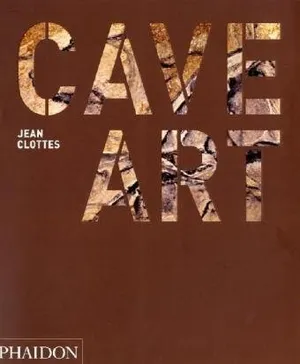
Related Reads
Get the latest History stories in your inbox?
Click to visit our Privacy Statement .
/https://tf-cmsv2-smithsonianmag-media.s3.amazonaws.com/accounts/headshot/Screen_Shot_2021-09-15_at_12.44.05_PM.png)
Joshua Hammer | READ MORE
Joshua Hammer is a contributing writer to Smithsonian magazine and the author of several books, including The Bad-Ass Librarians of Timbuktu: And Their Race to Save the World's Most Precious Manuscripts and The Falcon Thief: A True Tale of Adventure, Treachery, and the Hunt for the Perfect Bird .

Virtual Tour: Chauvet-Pont d’Arc Cave
Some of the most spectacular examples of prehistoric artwork cannot be found in a museum. Instead, you need to visit a place like Ardèche in Southern France to view some of the best preserved cave paintings in history—and best of all, you can explore this cave from the comfort of your home. The cave contains hundreds of paintings of animals and other figures, as well as fossilized remains and evidence of early human life.
Some of the highlights of the Chauvet-Pont d’Arc Cave virtual tour include:
Bison of the Pillar: Two bison drawn in black and then engraved. See how the lower bison has been partially erased? This is due to the passage of bears through the cave, slowly rubbing off the painting over time.
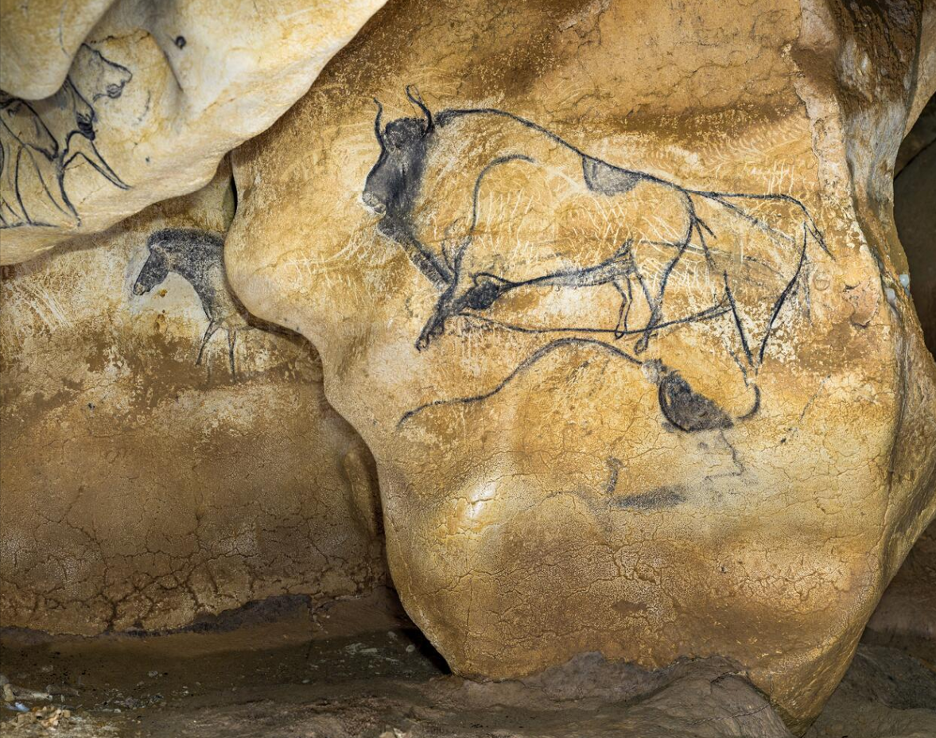
Panel of the Positive Hand Prints : Most children have made handprint art in school—well these handprints are thousands of years old, left behind alongside engravings and drawings of 50 different animal species.

The Cactus Gallery: One of the more intriguing elements of the cave developed after its human and animal inhabitants’ time—these striking white calcite deposits from the Holocene Era offer some dramatic visuals unseen by the Paleolithic humans who created the paintings.
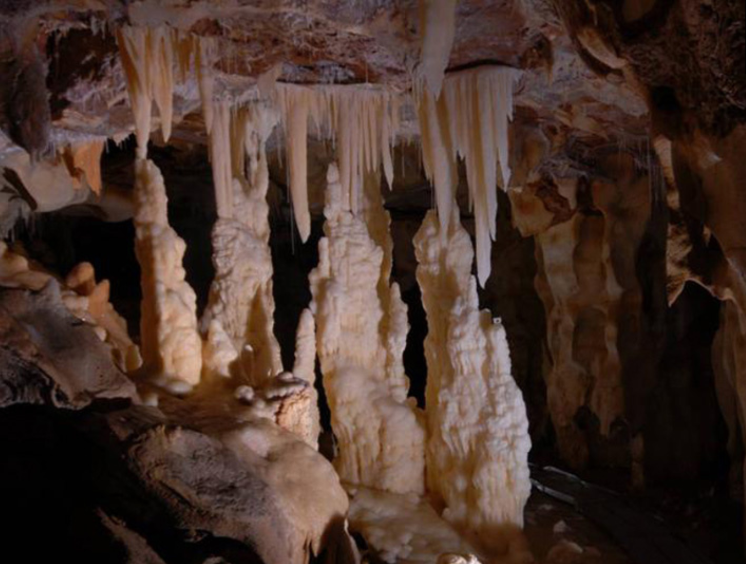
Skull Chamber: A spooky name for one of the most riveting chambers in the exhibit. The Skull Chamber has many areas to explore beyond the bear skull that provides its name.
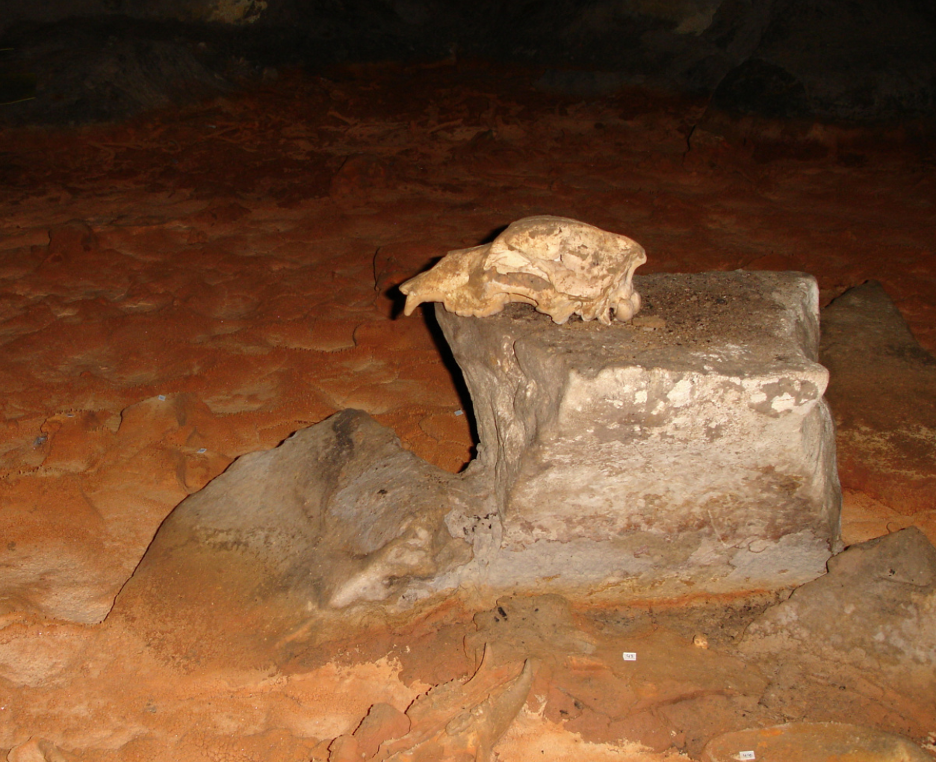
Curious to learn more about humans in prehistoric France? Visit the cave yourself and share what you find.
Why not subscribe to remain connected and informed?
Copyright 2024 © all rights reserved. design by elementor.
Privacy Policy
Chauvet Cave
- Ancient Civilizations
- Excavations
- History of Animal and Plant Domestication
- M.A., Anthropology, University of Iowa
- B.Ed., Illinois State University
Chauvet Cave (also known as Chauvet-Pont d'Arc) is currently the oldest known rock art site in the world, apparently dating to the Aurignacian period in France, about 30,000 to 32,000 years ago. The cave is located in the Pont-d'Arc Valley of Ardèche, France, at the entrance of the Ardèche gorges between the Cevennes and Rhone valleys. It extends horizontally for nearly 500 meters (~1,650 feet) into the earth and consists of two main rooms separated by a narrow hallway.
Paintings at Chauvet Cave
Over 420 paintings have been documented in the cave, including numerous realistic animals, human handprints, and abstract dot paintings. The paintings in the front hall are primarily red, created with the liberal applications of red ochre , while the ones in the back hall are mainly black designs, drawn with charcoal.
The paintings at Chauvet are highly realistic, which is unusual for this period in Paleolithic rock art. In one famous panel (a little bit is shown above) an entire pride of lions is illustrated, and the feeling of movement and power of the animals is tangible even in photographs of the cave taken in poor light and at low resolution.
Archaeological Investigation
The preservation in the cave is remarkable. Archaeological material in Chauvet cave's deposits includes thousands of animal bones, including the bones of at least 190 cave bears ( Ursus spelaeus ). The remains of hearths , an ivory spearhead, and a human footprint have all been identified within the cave's deposits.
Chauvet Cave was discovered in 1994 by Jean-Marie Chauvet; the relatively recent discovery of this remarkably intact cave painting site has allowed researchers to closely control the excavations using modern methods. In addition, the researchers have worked to protect the site and its contents. Since 1996, the site has been under investigation by an international team led by Jean Clottes, combining geology, hydrology, paleontology, and conservation studies; and, since that time, it has been closed to the public, to preserve its fragile beauty.
Dating Chauvet
The dating of Chauvet cave is based on 46 AMS radiocarbon dates taken on tiny pieces of paint from the walls, conventional radiocarbon dates on human and animal bone, and Uranium/Thorium dates on speleothems (stalagmites).
The deep age of the paintings and their realism has led in some circles to a scholarly revision of the notion of paleolithic cave art styles: since radiocarbon dates are a more recent technology than the bulk of cave art studies, codified cave art styles are based on stylistic changes. Using this measure, Chauvet's art is closer to Solutrean or Magdalenian in age, at least 10,000 years later than the dates suggest. Paul Pettitt has questioned the dates, arguing that the radiocarbon dates within the cave are earlier than the paintings themselves, which he believes are Gravettian in style and date to no earlier than about 27,000 years ago.
Additional radiocarbon dating of the cave bear population continues to support the original date of the cave: the bone dates all fall between 37,000 and 29,000 years old. Further, samples from a nearby cave support the idea that cave bears may have been extinct in the region by 29,000 years ago. That would mean that the paintings, which include cave bears, must be at least 29,000 years old.
One possible explanation for the stylistic sophistication of Chauvet's paintings is that perhaps there was another entrance to the cave, that allowed later artists access to the cave walls. A study of the geomorphology of the cave vicinity published in 2012 (Sadier and colleagues 2012), argues that the cliff overhanging the cave collapsed repeatedly beginning 29,000 years ago, and sealed the only entrance at least 21,000 years ago. No other cave access point has ever been identified, and given the morphology of the cave, none is likely to be found. These findings do not resolve the Aurignacian/Gravettian debate, although even at 21,000 years of age, Chauvet cave remains the oldest known cave painting site.
Werner Herzog and Chauvet Cave
In late 2010, film director Werner Herzog presented a documentary film of Chauvet Cave, shot in three-dimensions, at the Toronto film festival. The film, Cave of the Forgotten Dreams , premiered in limited movie houses in the United States on April 29, 2011.
- Abadía OM, and Morales MRG. 2007. Thinking about 'style' in the 'post-stylistic era': reconstructing the stylistic context of Chauvet . Oxford Journal of Archaeology 26(2):109-125.
- Bahn PG. 1995. New developments in Pleistocene art. Evolutionary Anthropology 4(6):204-215.
- Bocherens H, Drucker DG, Billiou D, Geneste J-M, and van der Plicht J. 2006. Bears and humans in Chauvet Cave (Vallon-Pont-d'Arc, Ardèche, France): Insights from stable isotopes and radiocarbon dating of bone collagen. Journal of Human Evolution 50(3):370-376.
- Bon C, Berthonaud V, Fosse P, Gély B, Maksud F, Vitalis R, Philippe M, van der Plicht J, and Elalouf J-M. Low Regional Diversity Of Late Cave Bears Mitochondrial Journal of Archaeological Science In Press, Accepted Manuscript. Dna At The Time Of Chauvet Aurignacian Paintings.
- Chauvet J-M, Deschamps EB, and Hillaire C. 1996. Chauvet Cave: The world's oldest paintings, dating from around 31,000 BC. Minerva 7(4):17-22.
- Clottes J, and Lewis-Williams D. 1996. Upper Palaeolithic cave art: French and South African collaboration. Cambridge Archaeological Journal 6(1):137-163.
- Feruglio V. 2006 De la faune au bestiaire - La grotte Chauvet-Pont-d'Arc, aux origines de l'art pariétal paléolithique. Comptes Rendus Palevol 5(1-2):213-222.
- Genty D, Ghaleb B, Plagnes V, Causse C, Valladas H, Blamart D, Massault M, Geneste J-M, and Clottes J. 2004. Datations U/Th (TIMS) et 14C (AMS) des stalagmites de la grotte Chauvet (Ardèche, France) : intérêt pour la chronologie des événements naturels et anthropiques de la grotte. Comptes Rendus Palevol 3(8):629-642.
- Marshall M. 2011. Bear DNA hints at age of Chauvet cave art. The New Scientist 210(2809):10-10.
- Sadier B, Delannoy JJ, Benedetti L, Bourlés DL, Stéphane J, Geneste J-M, Lebatard A-E, and Arnold M. 2012. Further constraints on the Chauvet cave artwork elaboration. Proceedings of the National Academy of Sciences Early edition.
- Pettitt P. 2008. Art and the Middle-to-Upper Paleolithic transition in Europe: Comments on the archaeological arguments for an early Upper Paleolithic antiquity of the Grotte Chauvet art. Journal of Human Evolution 55(5):908-917.
- Sadier B, Delannoy JJ, Benedetti L, Bourlés DL, Stéphane J, Geneste J-M, Lebatard A-E, and Arnold M. 2012. Further constraints on the Chauvet cave artwork elaboration. Proceedings of the National Academy of Sciences Early edition.
- Cave Paintings, the Parietal Art of the Ancient World
- Upper Paleolithic Sites in Europe
- Nawarla Gabarnmang (Australia)
- Vindija Cave (Croatia)
- Portable Art From Upper Paleolithic Period
- Upper Paleolithic Art Lascaux Cave
- Ancient Flutes
- Cave Hyena (Crocuta Crocuta Spelaea)
- 10 Incredible Ancient Cave Paintings
- Upper Paleolithic - Modern Humans Take the World
- Aurignacian Period
- Ochre - The Oldest Known Natural Pigment in the World
- Top 10 Inventions in Ancient Human History
- Sima de los Huesos, the Pit of Bones
- High and Low Chronologies of the Mediterranean Bronze Age
- Dog History: How and Why Dogs were Domesticated

All these artists nonetheless adhered to same rules in their depictions of animals, humans, and geometric signs, and we can thus see that they shared the same culture and skills but not the same experience in creating art on cave walls. While there is, therefore, no reason to believe that all the artists were specialists, those who created the masterpieces certainly were, and they existed alongside the specialized flint knappers of this time, 36,000 years ago.
Due to the difficulty of accessing it and the symbolic meaning likely attributed to such a place, the art deep in caves, such as Chauvet, was probably meant to be seen by everyone, as well as for ritual activities. We must also remember that Paleolithic people made art on rock surfaces outside of caves as well, where it was visible to all, along the with engravings, sculptures and ornaments they made on bone, stone and shells that were part of their daily lives, and which they shared and exchanged among themselves. For them, like for us, art thus had many different meanings and functions in their society.

Though there are many rhinoceroses depicted in the cave, they are not all identical. Their morphology varies, as does the size and shape of their horns. We can thus distinguish between males and females. The two rhinoceroses of the Panel of the Horses are facing each other, and since this art respects animal behaviors while also being symbolic, this could represent a charging battle between two males during the rutting season.

Hunting scenes are rare in cave art and Paleolithic art in general. It is not until around 25,000 years ago that we see animals in association with arrows, such as at Lascaux . But are these really hunting scenes? Hunting was a predatory activity implying significant responsibility and the interaction between the living and their representation probably adhered to strict norms. Hunting as such was therefore of a sacred nature very rarely represented.
The animals represented are not always those that were eaten. Indeed, were mammoths, lions and rhinoceroses really “consumable”? These species were probably considered as symbols in the depiction of explanatory, religious or mythic histories and stories. We thus sense a great deal of empathy in these modes of animal depiction and can indeed perceive a respectful, or even appreciative, relationship between the artists and their models.
We regularly discover decorated caves in the regions where they are naturally concentrated, such as southwestern France and Cantabria in Spain, as well as in Africa, Australia and Indonesia. Many caves remain to be discovered.
The charcoal drawings are still so vivid - how can this relatively soft material be so durable? When wood charcoal is burned at a very high temperature, it is transformed into fossil carbon. Carbon is rather stable and can be preserved for a very long time if it is not crushed and thus mechanically destroyed. Due to its excellent preservation, Paleolithic artists could use it as a black pigment and, using the Carbon14 method, scientists today can date it up to at least 50,000 years ago.

Paleolithic people did not live in caves, or very rarely at most. They lived outside where there was sunlight and warmth. Life in a cave is too difficult. Around Chauvet cave , we thus find their dwelling sites in the valley or on the Ardèche plateaus. They often lived in camps in the open-air, or in the sheltered entrances of caves. Some of the sites already discovered and excavated in the region are documented and presented at the regional prehistory museum of Orgnac l’Aven in Ardèche ( https://www.orgnac.com/en/ )
On some panels, in chambers deep in the cave and thus completely confined for a long time, the first few millimeters of the surface of the limestone walls is altered. The artists superficially scraped this soft, brownish layer to expose the lighter colored and more consistent surfaces below. They were able to draw on these newly exposed surfaces with their fingers or with black charcoal. We see this process very well in the film if we watch attentively.
Walking at an average pace of one meter per second, it takes 28 minutes to walk from the cave entrance to the End Chamber. The film this also lasts 28 minutes.
Because the cave is deeply buried within the limestone cliff and its entrance was closed for 21,000 years, the temperature inside is around 12 degrees Celsius throughout the year. It is also humid. The area near the entrance is dryer than the deepest parts, where water puddles can accumulate after rainy periods.
Though none have been discovered in Chauvet cave , they have in other caves. These artifacts consist mostly of bird bone flutes with two, three, or even four holes. Stalagmites were used as lithophones in some caves but not at Chauvet, as least as far as we currently know. Future research may reveal new surprises.
Chauvet cave is quite long, extending along 400 meters, and there are thus tens of thousands of square meters of untouched walls. The artists in various periods used only the panels that were appropriate to their objectives at the time. Their choices could have been influenced by factors such as the location, the nature of the limestone surface, the shape of the chamber, or the size and morphology of the panels. This immense cave, like many others, was decorated for precise reasons. There are other caves, several kilometers long, which were decorated only in the first 200 or 300 meters, for example.
Rock Art Links
→ Rock Art on UNESCO’s World Heritage List → Colloquium - France/Spain October 2019 → L'Atlas de la grotte Chauvet-Pont d'Arc → The Final Passage → The Final Passage - FAQ → France Rock Art & Cave Paintings Archive → Chauvet Cave → Lascaux Cave → Niaux Cave → Cosquer Cave → Rouffignac Cave - Cave of the Hundred Mammoths → Bison of Tuc D'Audoubert → Geometric Signs & Symbols in Rock Art → The Paleolithic Cave Art of France → Dr Jean Clottes → Bradshaw Foundation → Rock Art Network

- Prehisto-Break
PREHISTO BREAK
Full day chauvet cave trip.
- Incentive Ardèche
- Exclusive cooking in Provence Tour
- UNESCO Week tour in Provence
- Private tour à la carte
- Wine and cheese tour
- Huguenot and protestant tour
- Préhisto-Break
- Full Day Cavern PRIVATE TOUR
- Transport transfer solution
- Full day trip I
- Full day trip II
The Concept
Full day trip i, full day trip ii*.
*If only one of the two sites is visited, it is possible that the route includes the entire Ardèche Canyon.
More information about the painted cave of Pont d'Arc, the Chauvet Cave, the Pont d'Arc or the Ardèche Canyon .
Préhisto Break ® Activities
- Chauvet Pont d'Arc Cavern :
Situated in Southern Ardèche, the Chauvet Cave of Vallon-Pont-D’Arc was discovered on 18 December 1994 by Jean-Marie Chauvet, Éliette Brunel and Christian Hillaire. Thanks to its quality and its conservation of parietal paintings that have been in existence for 36 000 years, the unique prehistoric cavity was recently designated as a UNESCO World Heritage Site.
This is the support of the first artistic and major exhibition which has seen to date.
A facsimile of 3000 square metres, the Cavern of Pont d’Arc, allows you to visit the Chauvet Cave Replicala. In a similar atmosphere within the real cavity, thanks to odours, humidity and darkness, you will be delighted by many paintings and engravings wich reprensent leons of the caverns, horses, mammo ths or woolly r hin oce roses … Admire the quality of artistic work. This visit is making you for the f ee l of t he real thing !
- Aven of Orgnac cave :
Feel closer to the Earth and explore the Aven of Orgnac which is the only tourist site in the region of Rhône-Alpes labelled as "Grand Site de France®". You can submerge yourself into a breathtaking beauty. Between Entre fines draperies and crystallizations, the underground cathedral will show you its most stunning geological treasures ! Reaching a depth of 121 metres, the sound and light lead to emotions and leave place to the imaginary.
- Cité of Prehistory museum:
The Cité of Prehistory museum is labelled "Musée de France©". In a new modern and decidedly structure which opened in February 2014, the visitor will discover 350 000 years of treasures dedicated to Prehistory. This staging mixes giant illustrations and interactive medias, videos, sound atmosphere, stuffed animals and everyday scenes which are recaptured. The visit combines tactile tools and multimedia materials with objects of this era (tools, weapons...). A surprising link which emphasizes Prehistory like you have ever seen before.
- Prehistoric techniques Workshop :
This activity is supervised by archaeologists. After a short introduction to the prehistoric environment which allows to reconstitute the context and living conditions of this era, the visitors will listen to a keynote about various used techniques to produce fire, paint with ochre or sharpen flints. Following a period of observation, they will become actors and will try to de reproduce these ancestral and essential ge stures of this era. They will participate in a little contest of spear thrower like the hunters practiced in that time.
- Tour in Ardèche canyon (OPTION)
During this escape, we take you in charge to follow the famous itinerary of Ardèche canyon.
During this tour, you will be able to admire the Pont d'Arc: a natural stone bridge across the river which is a real wonder of nature, at the foot of the cliffs where the Chauvet Cave, awarded UNESCO, is situated.
Regular stops will be established in order to enjoy the breathtaking lookouts and have some time to take pictures. Your local driver tour guide will answer your questions regarding fauna and flora, gastronomy, Prehistory and geology of the territory. You will be delighted by the stunning and marvellous nature.
- Tel./Phone: +33 (0)6 77 16 43 63
- Fax.: +33 (0)9 72 47 21 57
- 850 CHEMIN DU MERLANCON - 07700 SAINT JUST D'ARDECHE
- www.slice-of-france.com
- Travel Agency Slice of France
- EURL Capital 7500 euros
- R.C.S. Aubenas
- SIRET N° : 529 543 183 00014
- VAT N°: FR33529543183
- Licence N°: IM007110006
- General Sales Conditions
- Personalized tours from Provence to Ardeche
- Discover the French art de vivre
- Our team of professional travel guides
- Enter into the heart of undiscovered France
The Bears of Chauvet Cave
Could there be a symbolic link between our ancestors and this animal, grotte chauvet - unesco world heritage site.
Cave Bear (2015-04-25/2015-04-25) by smergc Grotte Chauvet - UNESCO World Heritage Site
The cave bear (Ursus spelaeus) are the big animals that visited the Chauvet Cave the most, making it a major European paleontological site for the study of this animal.
Cave Bear (Chauvet Cave) (2015-04-25/2015-04-25) by smergc Grotte Chauvet - UNESCO World Heritage Site
Why "cave bear"? Like some present-day bears, Ursus spelaeus looked for quiet, protected places to hibernate. During the mild season, the cave bear built up their body fat.
It was not uncommon for the bear to die during hibernation for lack of resources. However, it is precisely at the back of caves (the protected areas where the preservation of remains is the most substantial) that most remains of cave bears were found. But why is this bear named the "cave bear"?
The cave bear: origin, distribution, and behavior
Adult cave bears could reach a shoulder height of about 5 ft and when standing, cave bears were over nine feet tall. The species had a strong sexual dimorphism. Adult males could weigh up to 500 kg (1,000 lb) – about half as much as adult females. The distribution of cave bears was all across Europe, up to the forested foothills of the Ural Mountains in Russia. They seemed to have favored wooded areas where food resources were abundant. Bear remains are found throughout much of France (with the exception of lowland areas), in southern England, southern Germany, and northern Spain. The Crimea, the Balkans, and the Caucasus Mountains were also geographical areas that cave bears frequented.
Distinctive steep forehead of a cave bear skull (Chauvet cave, Ardèche) Grotte Chauvet - UNESCO World Heritage Site
Although they were carnivores, because of their anatomical characteristics, Ursus spelaeus had an omnivorous diet. At times even entirely herbivorous, as seen by the molars which adapted to chewing plants.
Possessing a skull marked by an accentuated fronto-nasal depression called the "frontal stop", cave bears were also distinguished by a pronounced tilt of their back due to an extension of the forelimb and a shortening of the tibias.
There were numerous bear bones found in the Chauvet Cave which were so well preserved that a scientific team has been able to reconstruct the genetic profile of one individual bear that died 32,000 years ago.
This study found that the brown bear, polar bear, and cave bear had a common ancestor that lived 1.6 million years ago.
Cave Bear Bones (2006/2006) by Jean Clottes Grotte Chauvet - UNESCO World Heritage Site
4040 animal bones were also found on the ground in the cave, and 3,700 of these were from bears (at least 190 male, female, adult, and juvenile specimens).
Cave bears used the Chauvet Cave to hibernate. Beside the ursine bones, other remnants of the bears are present: bear hollows, polished rock surfaces, scratchings on walls, and footprint tracks on the ground. It should be noted that the people of the Upper Paleolithic moved, and even staged, bear bones in the cave, but it is impossible to determine the intention that motivated these acts.
Accumulation of Cave Bear Bones (Chauvet Cave) (2008/2008) by L. Guichard/Perazio/smergc Grotte Chauvet - UNESCO World Heritage Site
The samples of fossil bones taken from the cave show when the bears might have occupied the caves. Thirty reliable dates were obtained from this study.
Two periods of occupation of the cave have been identified: between 48,000 and 41,500 years ago, and between 33,500 and 32,700 years ago. The second occupation of the cave by bears corresponds to the first phase of human ornamentation in the cave. However, this does not imply that bears and men were present in the cave at the same time.
Ossement d'ours des cavernes (grotte Chauvet, Ardèche) (2008/2008) by L. Guichard/Perazio/smergc Grotte Chauvet - UNESCO World Heritage Site
No bear bones have been found that date earlier than 32,700 years ago. At the same time, it is thought that cave bears disappeared 25,000 years ago, probably because of a cooling period that affected all of Europe and the ecosystems. Why do you think there are there no bones younger than 32,700 years old in the Chauvet Cave?
On the one hand, a very unimaginative explanation is that it is possible that samples more recent than 32,700 years ago exist but have not been collected yet. Cave bears could also have been prevented from entering the cave because of the collapse of the porch, which occurred around 29,000 years ago and blocked the natural entrance of the cave, effectively preventing large animals from accessing the cave.
Cave bear skull (Chauvet Cave, Ardèche) (2008/2008) by L. Guichard/Perazio/smergc Grotte Chauvet - UNESCO World Heritage Site
The most numerous remains in the Chauvet Cave belong to those which testify to its frequent visitation by prehistoric fauna: with 4,040 inventoried bones (about 90% of the potential outcropping on the ground according to researchers), the Chauvet Cave is an important source of paleontological resources.
It is noteworthy that cave bear bones are more abundant in the deep parts of the cave. The areas close to the porch, and therefore more exposed to climatic variations and predators, were less occupied by the animals.
Bear Bones (Chauvet Caves) (2015-04-25/2015-04-25) by smergc Grotte Chauvet - UNESCO World Heritage Site
The cave bear (Ursus spelaeus) represents the vast majority of the documented remains: there are more than 3,700 bone remains from a minimum number of 190 identified individuals (MNI). However, no connected or loose skeletons have been found. Articulated segments are limited to portions of vertebral columns only.
The bones are scattered in the caves, mainly by natural factors (sheet water flow, bear movements, decomposition, and alteration of bones, etc.) or more commonly thought by human action (deliberate relocation of bones). The most preserved bones are also the biggest (skulls, humerus, pelvis, large vertebrae) at the expense of small bones (teeth, ribs, carpal bones, phalanges, etc.). Apart from the bones, other remnants also give evidence of the occupation of the bears in the cave.
Rocky Surface polished by bears (Chauvet Cave) (2008/2008) by L. Guichard/Perazio/smergc Grotte Chauvet - UNESCO World Heritage Site
While walking in the deep parts of the cave, in total darkness, bears found their bearings by rubbing their flanks (side of the animal's body) against the walls of the cave.
Through this, the protruding sections of the walls were stripped of clay and the rock was polished.
Bauges d'ours des cavernes (grotte Chauvet, Ardèche) Grotte Chauvet - UNESCO World Heritage Site
To hibernate in the cave, cave bears created circular depressions on the ground, these were called bear hollows, and there were around 300 in the cave.
Often with a diameter of about 50 cm (19.5 in), the bear hollows are grouped together, creating dormitories (sleeping areas).
Cave Bear Claws (2008/2008) by L. Guichard/Perazio/smergc Grotte Chauvet - UNESCO World Heritage Site
As the bears scratched the walls of the cave, thousands of scratches have been recorded in the cave, with the largest number in the deepest chambers.
Often associated with areas where the bear hollows are concentrated, the scratches are in the form of three or five parallel grooves with a depth and thickness of a few inches. The average height of the scratches is mostly between 5 ft to 7 ft.
Bear Sign (Chauvet Cave) Grotte Chauvet - UNESCO World Heritage Site
In chambers with flat floors, long tracks measuring over 30 ft were formed by bear paws to help reconstruct the wanderings of these animals in the cave.
In spite of the large number of identified ursine bones, the tracks correspond to a small number of individuals. In addition, these tracks and isolated footprints exhibit a great variability of individuals like that of the bones. Finally, based on their size and morphology, bear footprints identified in the Bear Hollow Chamber and the Hillaire Chamber seem to belong to Ursus arctos, another species of bear that frequented the Chauvet Cave.
Cave Bear (Chauvet Cave) (2008/2008) by L. Guichard/Perazio/smergc Grotte Chauvet - UNESCO World Heritage Site
The cave bear in cave art
Cave bears are poorly represented in European Paleolithic rock art. Only around 60 representations have been identified.
On its own, the Chauvet Cave contains 15, showing the importance of this animal to the Paleolithic cultures that decorated the Ardèche cave.
Cactus Room (Chauvet Cave) (2008/2008) by L. Guichard/Perazio/smergc Grotte Chauvet - UNESCO World Heritage Site
The representations of bears are concentrated in the first half of the cave, the red sector. 13 bears have been counted there, most of them drawn in red. In the black sector, the bear is represented once with charcoal and twice by scraping on clay.
The Cactus Chamber has representations of bears, including one of the most majestic in the cave.
Bear of Cactus Gallery (Chauvet Cave) (2008/2008) by L. Guichard/Perazio/smergc Grotte Chauvet - UNESCO World Heritage Site
The style used for drawing is similar throughout the cave. They are represented head down, with the back line disengaged from the shoulder. The skull is well equipped with the "frontal stop".
These red bears seem to have been made in three lines just like what prehistorians Valérie Feruglio and Dominique Baffier write: "The first [line] designates the front and the stop, and ends in a comma to indicate the nostril. The second designates the mouth and the third the chin and jowls."
Black Bear (Chauvet Cave) Grotte Chauvet - UNESCO World Heritage Site
The representation of the cave bear demonstrates a peculiarity compared to the 13 other animal species in the Chauvet Cave. The eye is never represented. In addition, they are never present in the monumental frescoes.
Black bears were drawn with charcoal and, like the red bears, their contours are partially faded.
Cave Bear Teeth (Chauvet Cave) (2008/2008) by L. Guichard/Perazio/smergc Grotte Chauvet - UNESCO World Heritage Site
Arrangement and staging of bear bones
Apart from the parietal art, the Chauvet Cave has other cultural testimonies, which were sometimes just as spectacular. It has been proven that cave bear bones were manipulated, sometimes staged by people in the cave, offering a fresh look at the occupation of the Chauvet Cave by Upper Paleolithic people.
Bear Humerus and Bear Skull (Chauvet Cave) (2008/2008) by L. Guichard/Perazio/smergc Grotte Chauvet - UNESCO World Heritage Site
Two humerus bones were found upright in the soil. One of them, located against a wall, seems to have been intentionally stuck in the ground.
The vertical position of the humerus associated with a bear skull is more uncertain. Located at a distance of about 10 m from each other, they are close to the natural porch where animals and humans entered the cave.
There were about 130 bones in the cave. These bones, concentrated in small areas, were naturally carried by water or moved by animals.
Human action could also explain some piles that appear to have been staged, such as these two bear skulls arranged close to each other.
Cave Bear Skull (Chauvet Cave) (2008/2008) by L. Guichard/Perazio/smergc Grotte Chauvet - UNESCO World Heritage Site
The Skull Chamber
In the Skull Chamber, a boulder that fell naturally from the vaulted ceiling is topped by a female bear skull deliberately placed there by a human (or humans) more than 21,000 years ago when the cave was still accessible.
On the surface of the boulder and under the skull are numerous charcoal fragments.
On the periphery of this skull, 53 bear skulls covered with a calcite formation created when the chamber was underwater have been documented. No other post-skeletal bone is visible on the surface.
What is the origin of these bear skulls arranged without apparent organization? Do they have a natural origin (dead bears in situ, bones displaced by animals or transported by water runoff), or were they brought and deposited by men? The origin of these bear skulls remains a point of debate.
A cave bear cult?
With the Chauvet Cave, it is tempting to hypothesize a strong symbolic link between man and cave bear. Despite the artifacts in the Chauvet Cave, there are no hard facts that could show that the bear was a major part of human spirituality 36,000 years ago.
In broader terms, the examination of archeological material from European sites does not support the hypothesis that there is a particular symbolic place for the bear within human cultures of the Upper Paleolithic. The bear cult, entertained since the 1920s, has not been confirmed by tangible archeological facts of today.
The Syndicat mixte de l'Espace de restitution de la grotte Chauvet (Public Union to manage the Chauvet Cave/SMERGC) thanks the Ministry of Culture and Communication. This exhibition was created as part of an agreement linking these two partners to promote the Chauvet Cave and its geographical and historical context. SMERGC is the designer, developer and owner of the La Grotte Chauvet 2 site (formerly known as Caverne du Pont d'Arc). It prepared and defended the application package of the Chauvet Cave for inclusion in the UNESCO World Heritage List. http://lacavernedupontdarc.org/ https://www.facebook.com/lagrottechauvet2/ SMERGC also thanks Google Arts & Culture. Bibliography (1) URL : https://www.researchgate.net/publication/283364757_Ursides_pleistocenes_des_Pyrenees_Elements_de_paleontologie_et_de_paleobiologie (2) https://www.persee.fr/doc/bspf_0249-7638_2005_num_102_1_13340 (3) http://www.sekj.org/PDF/anzf36/anzf36-093p.pdf (4) https://onlinelibrary.wiley.com/doi/full/10.1002/jqs.2883 (5) https://pdfs.semanticscholar.org/5fda/ceb8dc9d8a74823e3e42b89a7634e74a9d17.pdf (6) http://www.pnas.org/content/113/17/4670 (7) http://www.pnas.org/content/109/21/8002 (8) https://www.persee.fr/doc/bspf_0249-7638_2005_num_102_1_13340 (9) http://www.seuil.com/ouvrage/la-grotte-chauvet-jean-clottes/9782021022087
The Bear Hollow Chamber
The skull chamber and the lattices gallery, the end chamber, the candle chamber, chauvet cave: the first known masterpiece of humanity, the brunel room, the hillaire chamber, the red panels gallery, the megaloceros gallery, meet the people of the chauvet cave.
The Chauvet-Pont d'Arc cave
Discovered on Sunday 18 December 1994 by Jean-Marie Chauvet, Éliette Brunel and Christian Hillaire during a private speleological exploration, the Chauvet-Pont d'Arc cave is one of the oldest decorated Palaeolithic caves in the world.
- archeologie.culture.fr
- Share on Facebook
- Share on Twitter

The "Chauvet-Pont d’Arc Decorated Cave" was placed on the Unesco World Heritage List on 22 June 2014, at the Heritage Committee in Qatar.
This Unesco status applies to the whole cave, the surrounding natural landscape and the cave's groundwater basin, including the natural arch of Pont-d'Arc.
Selection criteria:
- Criterion (i): to represent a masterpiece of human creative genius
Unique and exceptional example of human creative genius in the Upper Palaeolithic, it leads us to question data on artistic and symbolic practices in this early period of human history.
- Criterion (iii): to bear a unique testimony to a civilisation which has disappeared
The most important known testimony to date on passage in the caves decorated in the Upper Palaeolithic and on Aurignacian civilisation, it is a mine of information on the paleo-fauna of the period, particularly cave bears, a now disappeared species.
Implications
International recognition and visibility
Mobilisation of the research community to study underground landscapes and cave art on a global scale
Sharing and transmission to future generations
Bringing together all the actors for concerted action with scientific, cultural, tourist, economic and land planning implications, etc.
- Chauvet-Pont d’Arc Decorated Cave
- World Heritage Committee in Qatar
- Application Dossier

IMAGES
VIDEO
COMMENTS
You cannot tour the original Chauvet Cave. Luckily, Chauvet Cave 2 is a near-perfect replica (apart from the shape), which you are more than welcome to tour. The day tours are guided 1-hour visits inside the cave. If you'd prefer to visit independently, you can do a self-guided tour in the evening. How guided Chauvet Cave tours work:
Many visitors, including the filmmaker Werner Herzog, the director of the Chauvet documentary Cave of Forgotten Dreams, had marveled at the paintings contained in this last gallery - perhaps the ...
The Chauvet-Pont d'Arc cave. Discovered on Sunday 18 December 1994 by Jean-Marie Chauvet, Éliette Brunel and Christian Hillaire during a private speleological exploration, the Chauvet-Pont d'Arc cave is one of the oldest decorated Palaeolithic caves in the world. archeologie.culture.fr. Close.
Visit the Chauvet cave. As you can see, you are not allowed to visit the original cave. On the other hand, the replica is open to all, all year round. You should allow ½ day to visit the whole site because more than just the cave, Chauvet 2 also offers an interpretation centre to better understand who the men were who left us this wonderful ...
28 - Jean Clottes - Experts' visit on 29 December 1994. Jean Clottes describes the experts' visit to Chauvet-Pont d'Arc Cave, which he led on 29 December 1994, a few days after it was first discovered. Marc Azéma. Centre National de Préhistoire. Ministère de la Culture et de la Communication
The Chauvet-Pont-d'Arc Cave (French: Grotte Chauvet-Pont d'Arc, French pronunciation: [ɡʁɔt ʃovɛ pɔ̃ daʁk]) in the Ardèche department of southeastern France is a cave that contains some of the best-preserved figurative cave paintings in the world, as well as other evidence of Upper Paleolithic life. It is located near the commune of Vallon-Pont-d'Arc on a limestone cliff above the ...
You can visit a scale replica of the Chauvet Cave paintings. The world-famous Paleolithic cave paintings at Lascaux, not far from Pont d'Arc, ...
The cave can be found in Vallon-Pont-d'Arc. It is open every day, all year round. Ticket price: Adults: from €17. Young people (10 to 17 years old): €8.50. Children under 10: free. Annual pass: €25 / year. With your entrance ticket, you have access to the guided tour of Chauvet 2 Cave (approx. 1 hour), and also a self-guided tour of the ...
Discovered on Sunday 18 December 1994 by Jean-Marie Chauvet, Éliette Brunel and Christian Hillaire on a private speleological expedition, the Cave of Pont d'Arc, known as Grotte Chauvet-Pont d'Arc, is one of the oldest decorated palaeolithic caves in the world. Visit the website. Accueil.
The Chauvet Cave was discovered in the Ardèche valley (in southern France) in December 1994 by three cave explorers, after removing the rumble of stones that blocked a passage.. The cave is extensive, about 400 meters long, with vast chambers. The floor of the cave is littered with archaeological and palaeontological remains, including the skulls and bones of cave bears, which hibernated ...
The Chauvet Cave (also known as the Chauvet-Pont-d'Arc Cave) is a Palaeolithic cave situated near Vallon-Pont-d'Arc in the Ardèche region of southern France that houses impeccably preserved, exquisite examples of prehistoric art. Now reliably dated to between c. 33,000 and c. 30,000 years ago, the numerous and diverse animals that dot the interior walls of the cave - both painted and ...
The Chauvet Cave is the first known masterpiece of humanity. Estimated to be 36,000 years old, the Chauvet Cave art has more than 1,000 drawings and engravings. Animals are a central focus of the panels and frescoes in the cave, and this art tells stories of our history. UNESCO has recognized the cave's state of conservation, rich heritage ...
Visit Grotte Chauvet (Chauvet Cave), a cave network with some of the earliest prehistoric human cave paintings in the world. Located in the Rhône Alps, France. ... Photos are not allowed inside the cave. Inside, you will see tens of small animal paintings, depicting at least 13 different species. There is everything from horses, lions ...
"The visit [to the Chauvet Cave] on December 24th was a great convivial moment," he said. "Everything that happened afterward was a pity. But we were there first, on the 18th of December.
Some of the highlights of the Chauvet-Pont d'Arc Cave virtual tour include: Bison of the Pillar: Two bison drawn in black and then engraved. See how the lower bison has been partially erased? This is due to the passage of bears through the cave, slowly rubbing off the painting over time. Panel of the Positive Hand Prints: Most children have ...
Chauvet Cave. Chauvet Cave (also known as Chauvet-Pont d'Arc) is currently the oldest known rock art site in the world, apparently dating to the Aurignacian period in France, about 30,000 to 32,000 years ago. The cave is located in the Pont-d'Arc Valley of Ardèche, France, at the entrance of the Ardèche gorges between the Cevennes and Rhone ...
The Discovery. On Sunday 18 December 1994, on the Cirque d'Estre, Jean-Marie Chauvet, led his two friends Éliette Brunel and Christian Hillaire towards the cliffs: a slight breeze coming out of a small hole, at the end of a little cave drew his attention, and he wanted to investigate. All three of them are passionate speleologists, and have ...
The artists of Chauvet cave used a great diversity of techniques to create its equally diverse artworks, ranging from monumental to very discrete. It is thus certain that many artists with varied and distinct skills participated in this endeavor. We can distinguish prodigious artists who mastered form, color, and figurative rendering on the rock walls from others who drew simple, less visible ...
Chauvet Cave. The Chauvet Cave in Ardèche, France is home to some of the most ancient human art ever known. The cave has been sealed off to the public since its discovery in 1994 to preserve the fragile and irreplaceable art that has survived undisturbed for 36,000 years. Explore in Augmented Reality the Horses Fresco and the Engraved Horse Panel.
A facsimile of 3000 square metres, the Cavern of Pont d'Arc, allows you to visit the Chauvet Cave Replicala. In a similar atmosphere within the real cavity, thanks to odours, humidity and darkness, you will be delighted by many paintings and engravings wich reprensent leons of the caverns, horses, mammo ths or woolly r hin oce roses ...
In conjunction with the global digital film premiere of The Final Passage, a 28-minute immersive experience of the Chauvet-Pont d'Arc Cave and its paintings,...
Cave Bear Skull (Chauvet Cave) (2008/2008) by L. Guichard/Perazio/smergc Grotte Chauvet - UNESCO World Heritage Site. On the periphery of this skull, 53 bear skulls covered with a calcite formation created when the chamber was underwater have been documented. No other post-skeletal bone is visible on the surface.
The "Chauvet-Pont d'Arc Decorated Cave" was placed on the Unesco World Heritage List on 22 June 2014, at the Heritage Committee in Qatar. This Unesco status applies to the whole cave, the surrounding natural landscape and the cave's groundwater basin, including the natural arch of Pont-d'Arc. Selection criteria: